INTANGIBLE HERITAGE
THE ART OF JAPAN’S LIVING NATIONAL TREASURES

ASIA WEEK NEW YORK DAI ICHI ARTS, LTD. SPRING 2023 EXHIBITION CATALOG

Dai Ichi Arts, Ltd. is a fine art gallery that is exclusively devoted to showcasing Modern & Contemporary ceramic works of art from Japan.

Since our beginning in 1989, we have been focused on highlighting important Japanese ceramics to the contemporary art scene in New York City. The gallery has introduced pieces to the permanent collections of several major museums including The Metropolitan Museum of Art, The Art Institute of Chicago, Minneapolis Institute of Art, Indianapolis Art Museum, Smith College Museum of Art, The Princeton University Art Museum, and many more.
We are committed to providing leading expertise to collectors, liaising with artists, and showcasing inspiring exhibitions & artworks. We welcome you to contact us for more details.
Intangible Heritage:
The Art of Japan’s Living National Treasures
Exhibiting at:
18 East 64th Street, Suite 1F




New York, NY, 10065, USA
Exhibition Catalog
March 1 – 31, 2023
CREDITS & CATALOG COVER IMAGES
AUTHORSHIP
Beatrice Lei Chang: Curator
With essays by: Daniel McOwan
Editor & catalog design: Kristie Lui
CATALOG PRODUCTION
Kristie Lui
Miyazaki Haruka
PRINT PRODUCTION
Amax Printing Inc., 6417 Grand Avenue, Maspeth New York, NY 11378, USA
All Japanese names in this catalog are provided in Japanese sequence with family name first, and given name second.
COVER (FRONT)
MATSUI Kosei 松井 康成 (1927-2003) Jar, Neriage, Cleft Marbled 練上嘯裂壺 (Shoretsu),1985
(h) 7.5” x (Diameter) 8”; (h) 19.0 x (Diameter) 20.3 cm
Marbleized Stoneware With Signed Wood Box
COVER (FRONT INSIDE)
KONDO Yuzo 近藤 悠三 (1902-1985)
Pair of Sometsuke Jars Porcelain, With Signed Wooden Boxes
COVER (BACK) Group image, Living National Treasures
COVER (BACK INSIDE)
MATSUI Kosei 松井 康成 (1927-2003) Jar, Neriage, Glaze Marbled 萃瓷練上壺 (Suiji Neriage), Early 1990’s
(h) 6.5”x (Diameter) 6.8”; (h) 6.5 x (Diameter) 17.2 cm
Marbleized Stoneware with Clear Glaze With Signed Wood Box
© 2023 By DAI ICHI ARTS, LTD.
INTANGIBLE HERITAGE
THE ART OF JAPAN’S LIVING NATIONAL TREASURES
FOREWORD
BY BEATRICE LEI CHANG
Shimizu Uichi 清水 卯一 (1926-2004)
Jar with Finger Scraped Patterns on Iron Glaze 鉄燿扁壺, 1988

(h) 10.5” x (w) 7.5” x (d) 7”; (h) 26.6 x (w) 19 x (d) 17.7cm
Stoneware with Iron Glaze
With Signed Wood Box
In 1954, Japan began a program of recognizing artists of elevated achievement with an honorary title and award of “Living National Treasure”. The award embraced the preservation of “treasure” that were intangible: a learned or trained skill rather than a physical object. This category encompassed craft groups of ceramics, paper, metalsmithing, textiles, lacquer ware and basketry. It was noteworthy for encouraging the preservation of Japanese crafts and their extension into innovative forms.
My journey through the world of Japanese ceramics began in 1989, when I joined Gallery Zero. Located at Rockefeller Center, Gallery Zero was the first gallery to introduce authentic Japanese ceramics of exceptional merit to the West, and New York city. I fell in love with the medium, history, and culture then. My passion for Japanese ceramics has now spanned three decades. During this time, I have traveled extensively in Japan meeting and working with many artists. Among them were Living National treasures Miura Koheiji, Shimaoka Tatsuzo, Isezaki Jun, Tokuda Yasukochi, Kato Takuo, and countless others. I was
fortunate enough to have them impart their priceless knowledge and worldviews to me.
The field of Japanese ceramics is enormous. Spanning the work of anonymous craftsmen, through the Mingei, or folk craft movement popularized through the writings about anonymous craftsmen by Yanagi Soetsu, to the government-endorsed Living National Treasure program, to the post war avant-garde sculptural scene of the Shikokai and Sodeisha movements in the 1940s and 50s. From “Kogei” to “Objet-yaki”, the boundless category of ceramic art continues to inspire me today.
We must consider that this category “Ceramic art” has spanned over a millennia of culture and study in Japan. Its history can be traced back to the Jomon period (Jomon jidai c. 14,000–300 BCE) when hand-coiled earthenware were produced for daily use. One can also muse upon the history of Japan’s “Six Ancient Kilns”, which flourished during medieval Japan and laid a fertile foundation of materials and techniques that informed Japanese
Japanese ceramics for centuries and into the present day. Siphoning from this rich heritage, today’s contemporary Japanese artists take advantage of the tools that our globalized world has to offer. They interpret and blend traditional techniques with new methods, while borrowing freely from international and pop culture trends. While doing so, they push the boundaries of the category of ceramic art. This exciting and brave new world, born from the post-war art scene of Japan, is full of muse and wonder.
Of the many ceramic artists working in Japan today, only a few will ever be rewarded with the designation “Living National Treasure”. But whether an artist aspires to that recognition or not, making pottery becomes an artist’s life. The appreciation and promotion of their art has become my mission. Together, we want to share the beauty of Japanese ceramics with the world.
Here, I borrow a quote from “Folk arts and Crafts of Japan”, by Kageo Muraoka and Kichiemon Okamura, who aptly articulates the heart and soul of Kogei:
“What is beauty? What is the art of the kiln? We cannot expect him to be prepared with clear cut answers to such questions, but even though he may not have a thoughtout knowledge, his hands move rapidly at his work. And we could perhaps say that just as the voice that speaks the Buddha’s name is not actually the man’s voice, but is that of the Buddha, so too the hands of the potters are not his own but are those of nature. Rath -
er than the craftsman directing the work, it is nature that comes and protects its beauty. The craftsman has forgotten all worldly cares. As belief grows out of selfless immersion in faith, beauty springs forth spontaneously in the vessels he makes. His creation thus holds me in rapt absorption.”
As the story of each artist moves us, the trials of each artist encourages us, I am fully aware of our responsibility and commitment. Your emails, your texts, your calls and your visits shine on my face and warm my heart. It is this sentiment of beauty, tradition, and passion that I want to share with the world. From Living National Treasures to the extraordinary artists who may be well on their way to capturing this high honor, My team and I bring what we consider to be the best of the best to your attention.
I would like to take this opportunity to thank Kristie Lui and Haruka Miyazaki for their diligent and professional work. My gratitude also goes to Daniel McOwan for his informative and insightful essay on this grand subject.
Beatrice Lei Chang February 2023
LIVING NATIONAL TREASURES
ESSAYS BY DANIEL MCOWAN EDITED BY KRISTIE LUI
TOKUDA Yasokichi III 3代 徳田八十吉 (1933-2009)
Designated LNT in 1997
Detail: Plate with Polychrome Enamel Overglaze

If there is one thing that gives Japanese craftspeople almost legendary status, both within and outside Japan, it is their appointment as a ‘Living National Treasure’. This term has become ubiquitous, and endows the awardee with a status that elevates their craft to a formal, nationally recognized level. Strictly speaking, the appointment is officially as ‘Preservers of Important Intangible Cultural Properties’ (Juyo Mukei Bunkazai Hojisha). However, the colloquial term is Living National Treasure (Ningen Kokuhou or LNT) used in Japan and elsewhere. As its correct title suggests, the intention of the award is to preserve ‘intangible’ (artistic) skills for the benefit of the nation. To achieve this, the Minister of Education, Culture, Sports, Science and Technology designates senior crafts people to be Living National Treasures. This covers all craft forms. The category also limits the number of Treasures to accommodate budgetary concerns, as each Living National Treasure gets an annual stipend of 2 million Yen. The number of treasures is also determined across all art forms, and there can only be one designated LNT at a time for each skill.
The origins of the Living National Treasures award dates back to the late 19th century, when the Meiji Emperor instituted the ‘Artists to the Imperial Household’ (Teishitsu gigei’in) system in 1890. This occurred because the government realised that Japanese arts and craft made a distinct contribution to the reputation of the nation and its economy. The
timing of it was also significant: The Meiji Emperor invested in these new policies just as these artistic skills were in danger of being lost as a consequence of the Meiji era reforms. This system was in place until 1944, during which seventy-nine artists were awarded. Of this number, only five ceramicists became an Artist to the Imperial Household: Seifu Yohei III (1851-1914) in 1893, Miyagawa (Makuzu) Kozan (1842-1916) in 1896, Suwa Sozan I (18521922), Ito Tozan I (1846-1920) in 1917, and finally, Itaya Hazan (1872-1963) in 1934.
In the post-war reconstruction, it was once again recognized that a similar award was advantageous for the nation for cultural reasons: certain skills were under threat of extinction. This brought about the enactment of the 1950 Law for the Protection of Cultural Properties, which emphasised the preservation of specific craft skills. This was slightly altered in 1954 to allow the designation of individuals and groups. The public directly associated the skill with the person, thinking that the person holding the title was the Living National Treasure, rather than the skill they practiced. The law not only awarded the person, but designated their skill and craft: It recognized both the skill and its holder as intangible cultural properties. Again, the Government of the day recognized the value of preserving the crafts. In particular, it recognized the value of maintaining craft skills of national significance.
While this is the legal framework for Living National Treasures, the actual criteria and assessment that underpins the appointment often indicates other factors at play. Some recipients were awarded specifically because their skill needed preservation, but others were awarded to see that a category of the nation’s craftspeople were represented. This is obvious from the start when, in 1955, Hamada Shoji (1894-1978) was awarded for his contribution to mingei ceramics whereas Tomimoto Kenkichi (1886-1963) was awarded for his skill in on-glaze enamelling (iro-e jiki). In reality both contribute to the maintenance of a tradition and that in itself achieves the desired outcome of the legislation.
The success of this system is indicated by the international recognition it has brought Japan. The system has also been imitated in China, Korea, The Philippines, Australia and Ireland, with adaptations to accommodate each nation’s respective cultural contexts. The scheme has been extended by some Japanese Prefectures, who have nominated their own holders of intangible cultural properties. These are regional awards for their craftspeople for their achievements and contributions to their prefecture. However, though these are not a national, imperial recognition in the same way the Living National Treasure designation is, they are still significant and lifetime achievements for many Japanese craftspeople.
It is worth noting that for all its benefits to the nominated craftspeople and to the Japanese Government for their enlightened patronage,
there are also critics of the Living National Treasure system. There is also debate about the politics behind the award. In particular, critics have scrutinized exactly how the award is nominated, given that there are great ceramicists and other major crafts people who have not been recognised. Among the ceramicists, for example, Kamoda Shoji (1933-1983) and Wada Morihiro (1947-2007) quickly come to mind and it would be easy to list a dozen living ceramicists who have not been awarded. Then, of course, there were the likes of Kitaoji Rosanjin (1883-1959) and Kawai Kanjiro (1890-1966) who choose to not accept their nomination for various reasons, or prominent ceramicists like Kato Tokuro (1898-1985) to whom it was never offered. The 1955 Law is applied pragmatically and in doing so, it has fallen short in some ways. Ultimately, the award creates a conversation about the importance of craft, and ultimately brings about recognition of the crafts in national and international discourse.
The Living National Treasures and their exceptional artworks you are about to encounter in this exhibition are sequenced in the order that they received their designation as Preservers of Important Intangible Cultural Properties, beginning in 1955.
Daniel McOwan January 2023
To commence the LNT designation, four ceramicists were designated. This included Tomimoto Kenkichi who was designated for his work in overglaze enamels (iro-e jiki). Unlike many of his peers, Tomimoto did not have a background in ceramics. He trained initially as an architect and interior designer, and following his graduation, he travelled to London (1908-1910) where he spent some time sketching in the Victoria and Albert Museum. This was his first exposure to the work of Ogata Kenzan (1663-1743) and to seeing ceramics as ‘art objects’ beyond functional ceramics. He returned to Japan in 1910 where, at a raku firing, he met and befriended Bernard Leach. Together they both experimented and developed their ceramic skills.
He taught and worked in Tokyo (1913-1926) where he coined the phrase ‘Never develop a pattern from a pattern’, an expression that
emphasized originality. He travelled extensively during this time and continued to develop his skills by visiting ceramic production centres across Japan. This included time in Kanazawa where he specifically studied the production of red-ground Kutani ware. Finally, he ended up teaching and working in Kyoto (1946-1963), where he developed the body of richly ornamented work that he is best known for today.
The covered jar from 1956 in the exhibition is from his Kyoto period where the richness of the old Imperial traditions is reflected in the rich colouration and precious metal decoration of the piece. It is covered with his fern leaf pattern that first appeared on his work in the 1950s and is perhaps the most elegant of all his patterns. Very little of his work appears outside Japan and a signature piece like this is a great rarity.
TOMIMOTO KENKICHI 富本 憲吉 (1886-1963)
餅を夢に 折り結ふ歯朶の 草枕
松尾芭蕉 (俳句)
I dream of rice cakes adorned with ferns on pillows of grass
Haiku, Matsuo Basho
 Covered Jar with Over Glaze Painting in Red, and Fern Pattern in Gold and Silver 色地金銀彩 羊歯文蓋付飾壷, 1956 (h) 7” x (Diameter) 10”; (h) 17.7 x (Diameter) 25.4cm Porcelain With Signed Wood Box
Covered Jar with Over Glaze Painting in Red, and Fern Pattern in Gold and Silver 色地金銀彩 羊歯文蓋付飾壷, 1956 (h) 7” x (Diameter) 10”; (h) 17.7 x (Diameter) 25.4cm Porcelain With Signed Wood Box
Hamada Shoji was also in this initial group of four ceramicists designated in 1955. He was designated for the preservation of Mingei ceramics. Hamada needs little introduction as he, and Kawai Kanjiro, became the prime exponents of the Mingei tradition, which has been both popular and influential inside and outside Japan. Indeed, it is hard to look at post-1945 ceramics without seeing the influence they exerted. Nonetheless, Hamada’s work remains significant and he is the true master of form and decoration.
The myriad copies of his forms not only attest to his influence but also emphasise just what a master of proportion he was. There is a balance in his work and a harmony of form and decoration that sets it apart. The abstract decoration of black and brown glazes on the
I live alone in a simple hut south-east of the capital: The feckless who fled the dejected world only to end up in melancholy.
jars in this exhibition exemplifies this. There is no doubt that it is Hamada’s work from the 1940s. The coloration also harks back to Northern Song-Jin Dynasty wares, and reflects the depth of ceramic culture that Hamada drew upon.
Today, Hamada Shoji is recognized as one of the most important figures in the history of Japanese ceramics. His work is widely admired for its beauty, simplicity, and respect for traditional forms. For his contribution to the international pottery scene, he was awarded the title of a Living National Treasure. Hamada’s legacy continues to inspire potters and craftsmen around the world.
わが庵は 都のたつみ しかぞ住む 世をうぢ山と 人はいふなり 百人一首 喜撰法師
Hyakunin Isshu, Priest Kisen
HAMADA
濱田 庄司 (1894-1978)
SHOJI
 Flat Jar, Black Iron Glaze with Finger Marks 指描黒角扁壺, 1940’s (h) 9.3” x (w) 6” x (d) 3” ; (h) 23.6 x (w) 15.2 x (d) 7.6 cm
Stoneware
With Signed Wood Box
Flat Jar, Black Iron Glaze with Finger Marks 指描黒角扁壺, 1940’s (h) 9.3” x (w) 6” x (d) 3” ; (h) 23.6 x (w) 15.2 x (d) 7.6 cm
Stoneware
With Signed Wood Box
HAMADA SHOJI 濱田 庄司 (1894-1978)
“Mukozuke” is a term referring to a deep bowl used for serving side dishes in the traditional Japanese meal, Kaiseki. The bowl is also used in the course preceeding Matcha drinking, in the Japanese tea ceremony.
 Pictured below: a group of works by Hamada Shoji, including three Mukozuke side dishes:
Pictured below: a group of works by Hamada Shoji, including three Mukozuke side dishes:
THE MINGEI MOVEMENT
In the 1950’s, potters and scholars Yanagi Soetsu, Hamada Shoji and Kawai Kanjiro launched the Mingei movement of the 20th century. This groundbreaking philosophy was inspired by anonymous craftsmen. Yanagi & Hamada established Mashiko region as a center for folk craft that inherently embodies ‘innate Japaneseness’. Within Mashiko, potters practiced the “Mingei philosophies” in their craft.
Yanagi constructed a “criterion of beauty”, which included “the beauty of selflessness and anonymity.” This creed was inspired from his praise of a single object created by an artisan called Minagawa Masu, who had been working for more than 60 years decorating pots with repetitive traditional patterns. His pots were unsigned, inexpensive, and ordinary kitchen items that lacked individuality. Inspired by Minagawa’s traditionality rooted in precepts of collectivism, Yanagi’s Mingei movement in Mashiko was conceived as a set of antithetical concepts. Hamada Shoji was a central figure in this folk-art movement. Interested in studio pottery: he established the town of Mashiko as a world-renowned pottery center, where he produced functional ceramics that showcase simplicity. Hamada was inspired particularly by the folk-craft techniques of ceramics from Okinawa and Korea. His significant influence on studio pottery is felt internationally, as seen in the works of Bernard Leach– a potter responsible for disseminating Japanese ceramic craft techniques in the West– and in the American folk-art movement.
Hamada’s designs convey simplicity and highlight the inherited techniques of craftsmanship in pottery passed down through generations in Japan. For example, he typified the persimmon and iron glazes, while demonstrating the excellence in forms: Bottles, pots, vases, plates.

Black Glazed Jar with Persimmon Glaze Trailing, 黒釉錆流掛方壺

(h) 9” x (Diameter) 7” x (Lip Diameter) 5.2”; (h) 22.8 x (Diameter)17.7 x (Lip Diameter) 13.2cm
Stoneware
With Signed Wood Box, Signed by His Son HAMADA Shinsaku
Hexagonal Vase with Persimmon Glaze, Red and Green Enamel 柿釉赤絵花生, 1960s (h) 7.7” x (Diameter) 3.5”; (h) 19.6 x (Diameter) 9 cm

Stoneware
With Signed Wood Box
朝ぼらけ 有明の月と見るまでに 吉野の里に 降れる白雪
百人一首 坂上是則
Kondo Yuzo was designated a Living National Treasure in 1977 for his work in underglaze cobalt blue (sometsuke). Following his graduation from the Kyoto School of Arts, he worked as an assistant for Tomimoto Kenkichi between 1921 to 1924, while employed on the recommendation of Shoji Hamada. For many years he was considered one of the most skillful potters in Kyoto.
As the story goes, Tomimoto eventually took him in hand and told him that unless he could draw, he would never be a great potter. Kondo responded by enrolling in courses specially teaching drawing and haltingly started applying these skills to his pots. The outcome of all his effort was a superb body of work where his dynamic, large scale decoration based on a set number of themes, reinvigorated the notion of just what blue and white decora-
At the break of day, Just as though the morning moon Lightened the dim scene, Yoshino’s fair hamlet lay In a haze of falling snow.
Hyakunin Isshu
Sakanoueno Korenori
tion could achieve. His skills as a potter still emerge in his work with high-shouldered vases. These forms are instantly recognisable as Kondo’s forms and are as much his hallmark as is their decoration.
Kondo’s themes – pomegranates, mountain ranges, pine, plum, bamboo and thistles reoccur in his work and have maintained their vivacity across time and in use on alternate forms. The pieces in this exhibition show the use of his motifs such as the thistle on both a cup and a vase, nicely proportioned to relation to the form they decorate. Landscape appears on the later box whose background has been gilt, perhaps a homage to later work by Tomimoto or simply Kondo’s response to the Imperial taste of old Kyoto. Again, they represent a highly original body of work and they have no equal.
KONDO
YUZO 近藤 悠三 (1902-1985)
 Blue and White Jar with Plum Drawing 梅染付壺
(h) 9.5” x (Diameter)9.8 ”
(h) 24.1 x (Diameter) 24.8 cm
Porcelain
With Signed Wood Box and Lacquer Box
Blue and White Jar with Plum Drawing 梅染付壺
(h) 9.5” x (Diameter)9.8 ”
(h) 24.1 x (Diameter) 24.8 cm
Porcelain
With Signed Wood Box and Lacquer Box

(h)
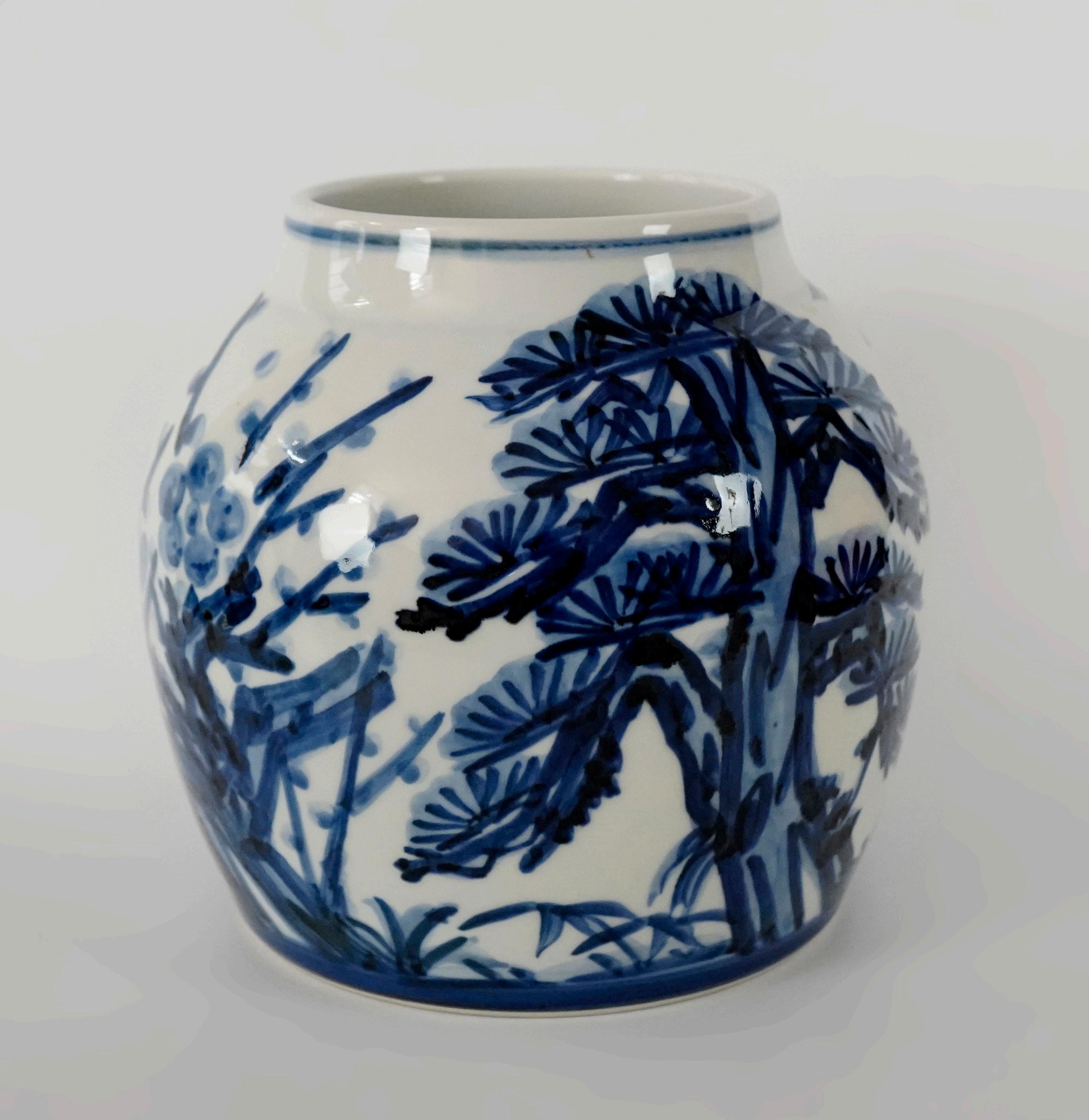
三友良寛詩染付壺
Blue and White Jar with Bamboo, Pine and Plum Drawing
9.4” x (Diameter) 9.8”, (h) 23.8 x (Diameter) 24.8 cm
Porcelain
With Signed Wood Box and Lacquer Box
(Left) Sometsuke Jar with Thistle Drawing 薊染付壺, 1967
(h) 8.2” x (Diameter) 8.5” x (Lip diameter) 5.4”
(h) 20.8 x (Diameter) 21.5” x (Lip diameter) 13.7cm Porcelain
With Signed Wood Box
見るうちは 吾も仏の 心かな
I watch the Buddha while my mind still remains Buddha-minded
Miwa Kyusetsu XI followed his older brother in becoming the Living National Treasure for the preservation of Hagi ware and was designated in 1983. Hagi ware is a high fired stoneware and is usually glazed with either a transparent glaze or a snow-white glaze that is made by adding rice straw ash to the clear glaze.
The origins of Hagi ware can be traced back to the late 16th century. The feudal lord of the Hagi region Terumoto Mori had appointed potters to create Hagi pottery for his personal tea ceremonies. Gradually, the taste for Hagi-yaki became more and more widespread, until the Meiji restoration in 1868, when it grew in popularity because potters could become independently employed. There are several types of Hagi ware, but the most fa-
mous is the white Hagi type developed by the Miwa. The Miwa family’s kiln was established in 1663, and has been operating ever since.
The Miwa family have been making tea ceramics since 1666, and it is beyond doubt that they have created the reputation of Hagi ware as the number two tea ceramic (after raku ware from Kyoto). Miwa Kyusetsu XI is the master of Hagi’s famous white glaze and the Mizusashi (water jar) in this exhibition is a superb example of his contribution to the family’s reputation as well as being an example of the long tradition of Hagi tea ceramics. The sensuality of the glaze invites both touch and taste.
MIWA KYUSETSU XI 11 代 三輪 休雪 (1910-2012)
夏目漱石(俳句)
Haiku, Natsume Soseki
Square Water Jar With White Hagi Ash Glaze 白萩四方水指, 2000s (h) 6.7” x (w) 7” x (d) 6.6”, Lid: (h) 1.2” x (Diameter) 3.9” (h) 17 x (w) 17.7 x (d) 16.7cm, Lid: (h) 3cm x (Diameter) 9.9 cm
Glazed Stoneware
With Signed Wood Box

My dear plum blossoms, When the east wind blows, send Some of the fragrances to me, Even if the master of the house Is out, don’t forget it is spring
SHIMIZU UICHI
Shimizu Uichi was designated in 1985 for his contributions using iron-containing glazes (tetsu-yu). His predecessor for this title was the great Ishiguro Munemaro (1893-1968), one of the original Living National Treasures designated in the 1955 group. Iron containing glazes suggests black or brown colouration but Shimizu Uichi created orange, white and celadon shades as well. As with the glazes used by Shoji Hamada iron containing glazes date back to Northern Song Dynasty wares but in Shimizu’s hands they were modernised and used on graceful forms to create a different way of using these glazes. The three vases in this exhibition are late works but demonstrate the power, confidence and skill of a master potter. His manipulation of the glaze disrupts its normal role and makes it the
statement of the piece. Here technique is taken for granted and the expression of an idea is the prime objective.
Alongside Hayashi Yasuo, Shimizu Uichi was a part of the avant-garde ceramicist group “Shikokai 四耕社” in the Kyoto scene during the post-war period in the 1950s and 60s. The movement permitted potters to re-conceptualize pottery outside of industry traditions of Japanese ceramics, which had been dominated by the idea that lineage- rather, potters who were children of pottery masters- granted credibility to ceramicists. Shimizu’s frank boldness rippled through the ceramics world in Japan and created fresh aesthetic values, tenets, and precedents for what permitted a ceramic art object.
清水
卯一 (1926-2004) 東風(こち)吹かば 匂ひおこせよ 梅の花 あるじなしとて 春な忘れそ 菅原道具(大鏡)
Sugawara no Michizane (The Great Mirror)
Jar with Finger Scraped Four Seasons Characters on Iron Glaze, 鉄燿扁壺 春夏秋冬 1988
(h) 10.1” x (w) 8” x (d) 7”; (h) 25.6 x (w) 20.3” x (d) 17.7cm Stoneware with Iron Glaze With Signed Wood Box

Flat Jar with White Glaze Over Iron Glaze 蓬菜掛分扁壺 山河, 1993
(h) 10” x (w) 8.3” x (w) 7”; (h) 25.4 x (w) 21.0 x (d) 17.7 cm
Stoneware
With Signed Wood Box
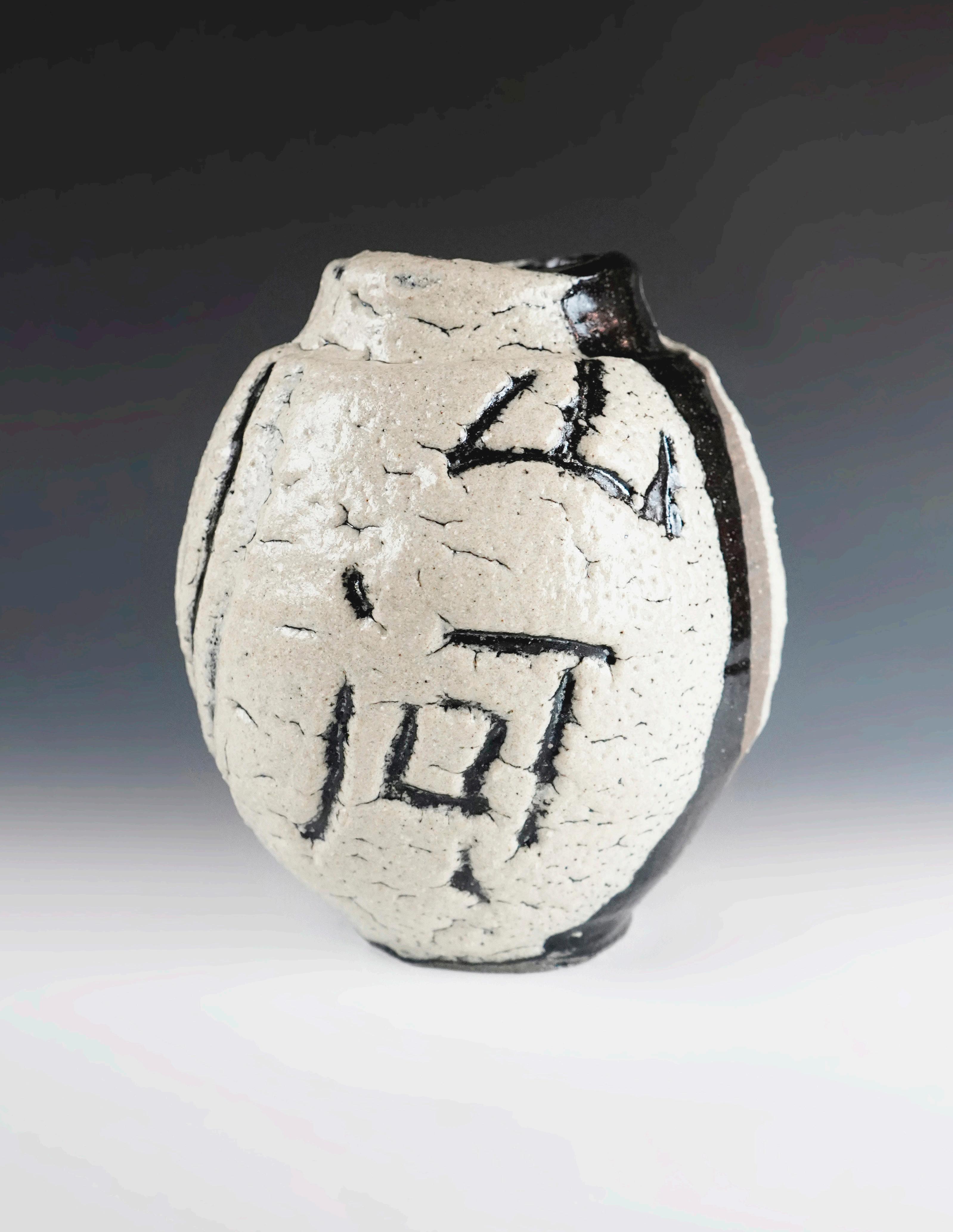
Finger Scraped Patterns
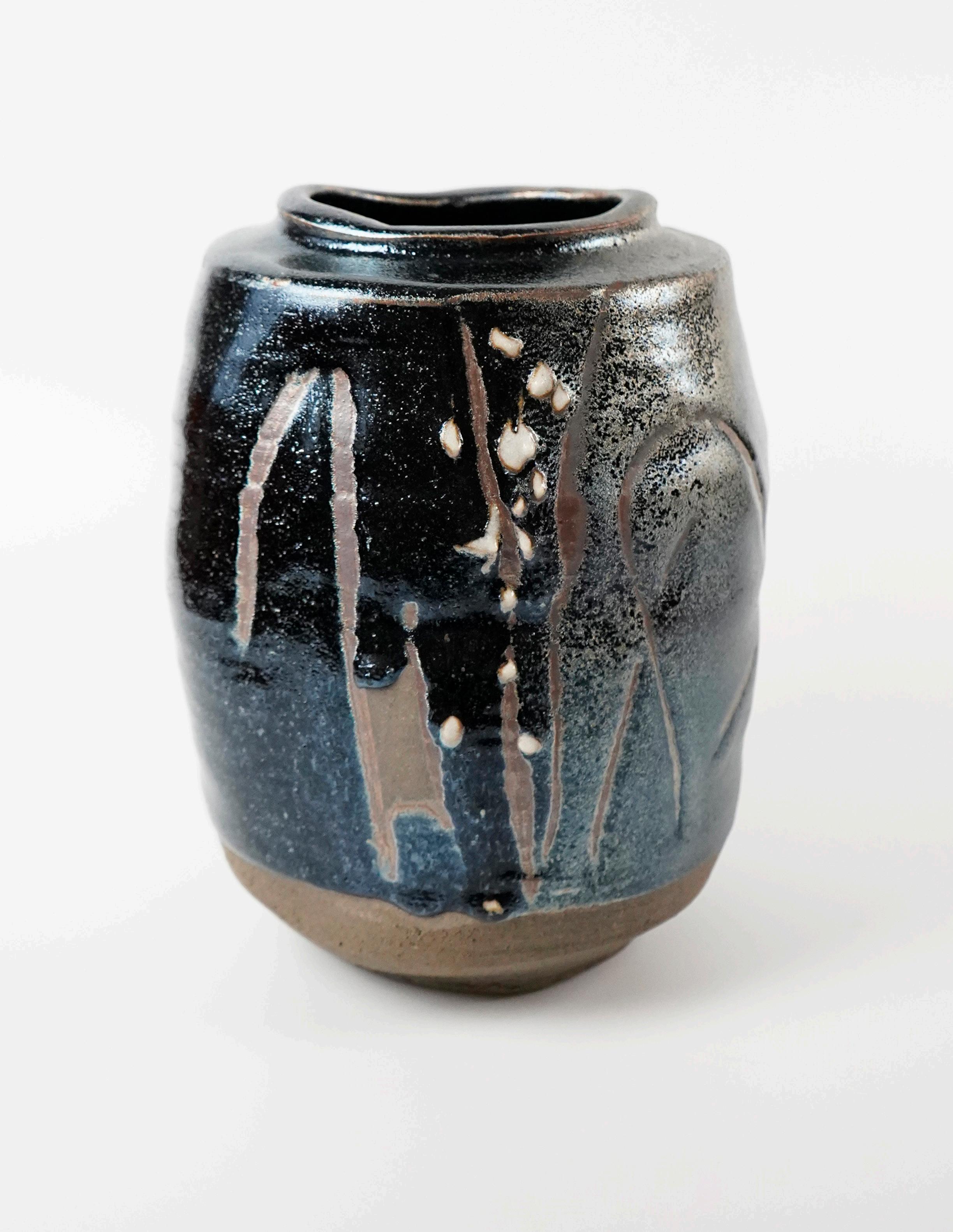 Jar with
on Iron Glaze 鉄燿扁壺, 1988 (h) 10.5” x (w) 7.5” x (d) 7”; (h) 26.6 x (w) 19 x (d) 17.7cm Stoneware with Iron Glaze With Signed Wood Box
Jar with
on Iron Glaze 鉄燿扁壺, 1988 (h) 10.5” x (w) 7.5” x (d) 7”; (h) 26.6 x (w) 19 x (d) 17.7cm Stoneware with Iron Glaze With Signed Wood Box
Tamura Koichi was designated in 1986 for his contributions using iron-based decoration (tetsu-e) in contrast to Shimizu Uichi’s ironbased glazes. Trained initially as an industrial designer he later came to ceramics through Tomimoto Kenkichi, for whom he was an assistant in Tomimoto’s early years in Kyoto (1946). Tamura was born and worked in Sano, near Mashiko, and was considered a Mingei potter. The superb early work in this exhibition, with grasses drawn against a yellow background, clearly shows Tamura’s mastery of using iron-based pigments for decoration. The use of impressionistic decoration became
Approaching a mountain path: In some way, The graceful violets.
his hallmark and has continued through to his later work.
He also honed his talent for image and the brush at the Art Academy (in the ceramic design department) in Tokyo. As a result, his iron glazed drawings and persimmon glazed wax-resist designs on his ceramic works are on a league entirely of their own. His talent for brushwork on the decorative surfaces shows in his invention of a technique where he brushes a white hakeme glaze under his iron-oxide adornments on his ceramics.
山路来て 何やらゆかし すみれ草
(俳句)
TAMURA KOICHI 田村 耕一 (1918-1987)
松尾芭蕉
Haiku, Matsuo Basho
Flower Vessel with Iron Drawing of Grass 野草文花器,1960’s (h) 8.8” x (Diameter) 7.5”; (h) 22.3 x (Diameter) 19.0 cm
Stoneware
With Signed Wood Box

The texture of paper; the quality of ink. These elements were core to Imaizumi Imaemon XIII’s classical porcelain works of art. As the thirteenth generation of a historical family of potters, Imaizumi Imaemon XIII’s understanding of the classical elements of Japanese art is foregrounded by a deep understanding of the subtlety and graceful qualities of Japanese Sumi-e painting.
Imaizumi Imaemon XIII was a descendant of the family who were initially decorators in the Nabeshima Daimyo kiln at Okawachi in Kyushu and he was designated in 1989 for his contribution to on-glaze enamel decoration (iro-e jiki). Much of the work of the Imaizumi family is red and blue enamels on a white background but Imaemon XIII has often experimented with a dark grey underglaze, sprayed, Uranium oxide ground (uzuzumi) and placed the on-glaze decoration against
Scented ume blossoms returning: it’s getting cold.
it. This background is reminiscent of the better-known sprayed Cobalt ground (fukuzumi) and is the signature technique of Imaizumi Imaemon XIII. The vase in the exhibition is a fine example of this unique technique.
Here, he glazes the blank porcelain surface with a textured background- as though priming a canvas- before painting on a meticulous decorative pattern of flora and fauna. The resulting effect on his Nabeshima porcelain is a slight drop shadow of the painted pattern as though the dark outlines of his adornments are relief forms that are raised from the paper-like porcelain surface. This illusory three-dimensional technique is subtle, and demands slow-looking from the viewer. For this precise technique, he was awarded the title of Living National Treasure in 1989.
IMAIZUMI IMAEMON XIII 13 代 今泉 今右衛門 (1926-2001)
梅が香に 追いもどさるる 寒さかな 松尾芭蕉 (俳句)
Haiku, Matsuo Basho
Vase with Overglaze Enamel Decoration and Flora 色絵 花瓶 (h) 8.4” x (Diameter) 8.5” x (Lip Diameter) 4.1”; (h) 21.3 x (Diameter) 21.5 x (Lip Diameter) 10.4 cm
Porcelain With Signed Wood Box

Matsui Kosei (1927-2003) stands alone among Japanese ceramists in his absolute mastery of the marbling or neriage technique for which he was designated in 1993. The three vases in the exhibition show progressively finer clay mixtures but other vases by him take this to almost a minute difference between the layers. Similarly, some of his pots have a coarse surface, reflecting the different clays in the mixtures, whereas others have a smooth surface that creates an intriguing multi-dimensional optical effect as the colours of the clay advance or recede. Whatever style he chooses the end result was always a visually challenging and simultaneously intriguing pot.
Matsui has honed the Neriage style to its ze -
The fifty years of man are a dream-like stupor under the light of heaven. Once born, Are we unbreakable?
nith. “Neriage”, or agateware is known for its swirling colorful clays that layer over each other. It originated in Tang China (7th-10th century) and was imported to Japan during the a period of technological exchange as a result of medieval maritime trade. The neriage technique requires extreme precision in combining sheets of different types of clay to create the desired decorative effect in a single coherent piece. Each type of clay has its own unique properties of color, form, and texture, and only an experienced artist may bring them together in a unified style. His pleasure in the technique led to constant innovation as he continually travelled to collect new ideas for his work.
MATSUI KOSEI 松井 康成 (1927-2003) 人間五十年
夢幻の如くなり 一度生を享け 滅せぬもののあるべきか 作者不詳(敦盛)
下天のうちをくらぶれば
幸若舞「敦盛」の一節
Kouwakamai, Unknown, From the Noh play “Atsumori”
Jar, Neriage, Glaze Marbleized 練上壺, 1986 (h) 10.2” x (Diameter) 10.2”; (h) 26 x (Diameter) 26 cm Marbleized Stoneware With Signed Wood Box
Published in: The Works of Kosei Matsui, 1985-1990 松井康成練上作品集
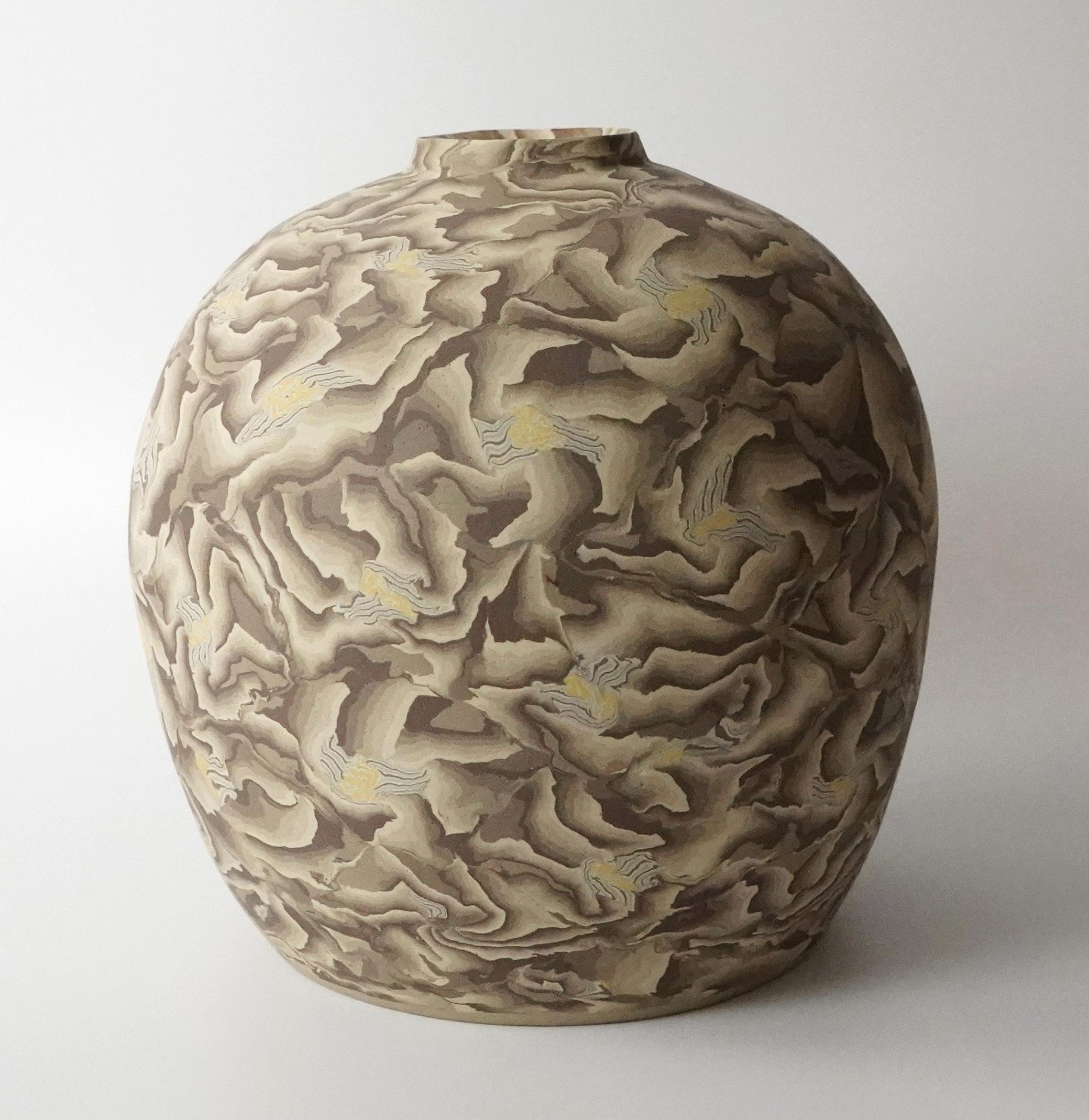


Jar, Neriage, Glaze Marbled 萃瓷練上壺 (Suiji Neriage), Early 1990’s

(h) 6.5”x (Diameter) 6.8”; (h) 6.5 x (Diameter) 17.2 cm
Marbleized Stoneware with Clear Glaze
With Signed Wood Box
Jar, Neriage, Cleft Marbled 練上嘯裂壺 (Shoretsu), 1985

(h) 7.5” x (Diameter) 8”; (h) 19.0 x (Diameter) 20.3 cm
Marbleized Stoneware With Signed Wood Box
Inoue Manji, like Imaizumi Imaemon XIII, hails from Kyushu but he represents the Arita tradition. Designated a Living National Treasure in 1995 for his work in white porcelain (hakuji) his work emphasises form, and when decorated it is through subtle underglaze engraving or quietly playing with the forms through simple fluting.
Hakuji porcelain reveals all and hides nothing! This characteristic is well matched for Inoue’s perfectionist attitude when it comes to his ceramics. The flawless surfaces of his white porcelain leaves little room for error. Any blemish, flaw, or imperfection is glaring. These principles echo Chinese Song dynasty porcelain and Longquan celadon type wares, where flawlessness in form and surface were
The spring ocean sways gently day by day.
sought after. Some of his work references early Chinese porcelains but the two vases in this exhibition are straightforward pieces of white porcelain that rely on their gracious forms for their impact.
Inoue’s forms are single-minded pursuit of perfection in form and finish. They sometimes feature “hidden” patterns of flora and fauna in the celadon surface. This elusive decoration can be achieved only through celadon and other translucent glazes. The vessel’s beholder becomes lost in the pure white celadon glaze, while a delicately carved complex pattern gradually reveals itself within a landscape of flawless splendor.
萬二
春の海 ひねもすのたり のたりかな 与謝蕪村(俳句)
INOUE MANJI 井上
(b. 1929)
Haiku, Yosa Buson
White Porcelain Jar with Faceted Impression 白磁面取壺 (h) 9.2” x (Diameter) 10” x (Lip diameter) 2.8”; (h) 23.3 x (Diameter) 25.4 x (Lip diameter) 7.1 cm
Porcelain with Transparent Glaze With Signed Wood Box


White
(h) 5.8” x (Diameter) 8.5” x (Lip diameter) 6.5”; (h)14.7 x (Diameter) 21.5 x(Lip diameter) 16.5 cm
Porcelain With Signed Wood Box
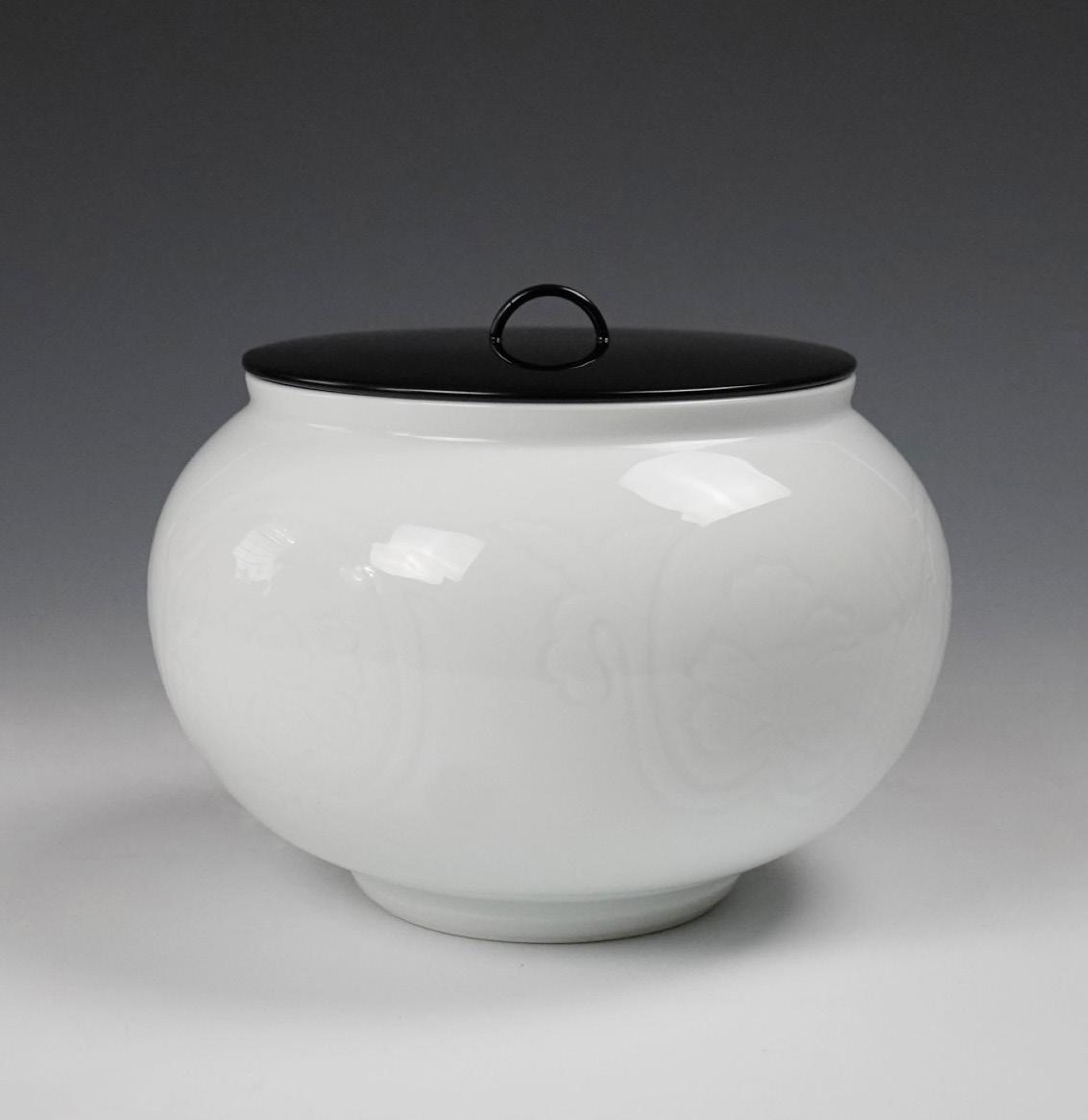 Porcelain Flower Vessel Incised with Peony Pattern 白磁牡丹彫文花器
Porcelain Flower Vessel Incised with Peony Pattern 白磁牡丹彫文花器
Kato Takuo is represented in this show with two pieces. One of them is an elegant porcelain vase with an abstract decoration of poured and splashed glazes that suggests vines and flowers. The other is a small stoneware jar with a Chinese style three-colour glaze (sancai).
Born into a family of pottery masters dating back to the late Edo period, he was first trained in the ceramic arts by his father, Kato Kobei, before going on to study at the Kyoto School of Ceramics. In 1965, he also traveled to Finland to continue his studies. Afterwards, he became fully immersed in the Kyoto pottery scene.
Kato is famous for his historical Persian and Chinese influenced pottery style. His ceramics evoke the interconnected global trade, economy, and cultural transmission of the 8th to 12th centuries. This can be seen in a variety of styles that he produced. For example, he was
The Horyuji bell, The bite of a persimmon, Suddenly sounding.
Haiku, Masaoka Shiki
interested in producing lustreware, a type of pottery bearing a metallic glaze, depicting royal hunting scenes, flora, and fauna. Lustreware was a popular export ceramic type that circulated from Persia to Europe in the 11th century.
Among his extensive porcelain repertoire, Kato also produced excellent examples of the famous “Sancai” glaze, or “Tri-color” glazes. This glaze type was traded commercially in the silk road trade during the Chinese Tang dynasty, where the style originated from.
Among his ceramic styles, Kato is most famous for his sancai porcelain production, a medium that has a long history of export and trade over lands, seas, and across time. Kato’s commitment to history and revival of medieval pottery styles earned him the designation of a Bearer of Intangible Cultural Heritage in 1995.
柿食えば 鐘が鳴るなり 法隆寺 正岡子規 (俳句)
KATO TAKUO 加藤 卓夫 (1917-2005)

Gosu Flower Vase 呉須花挿
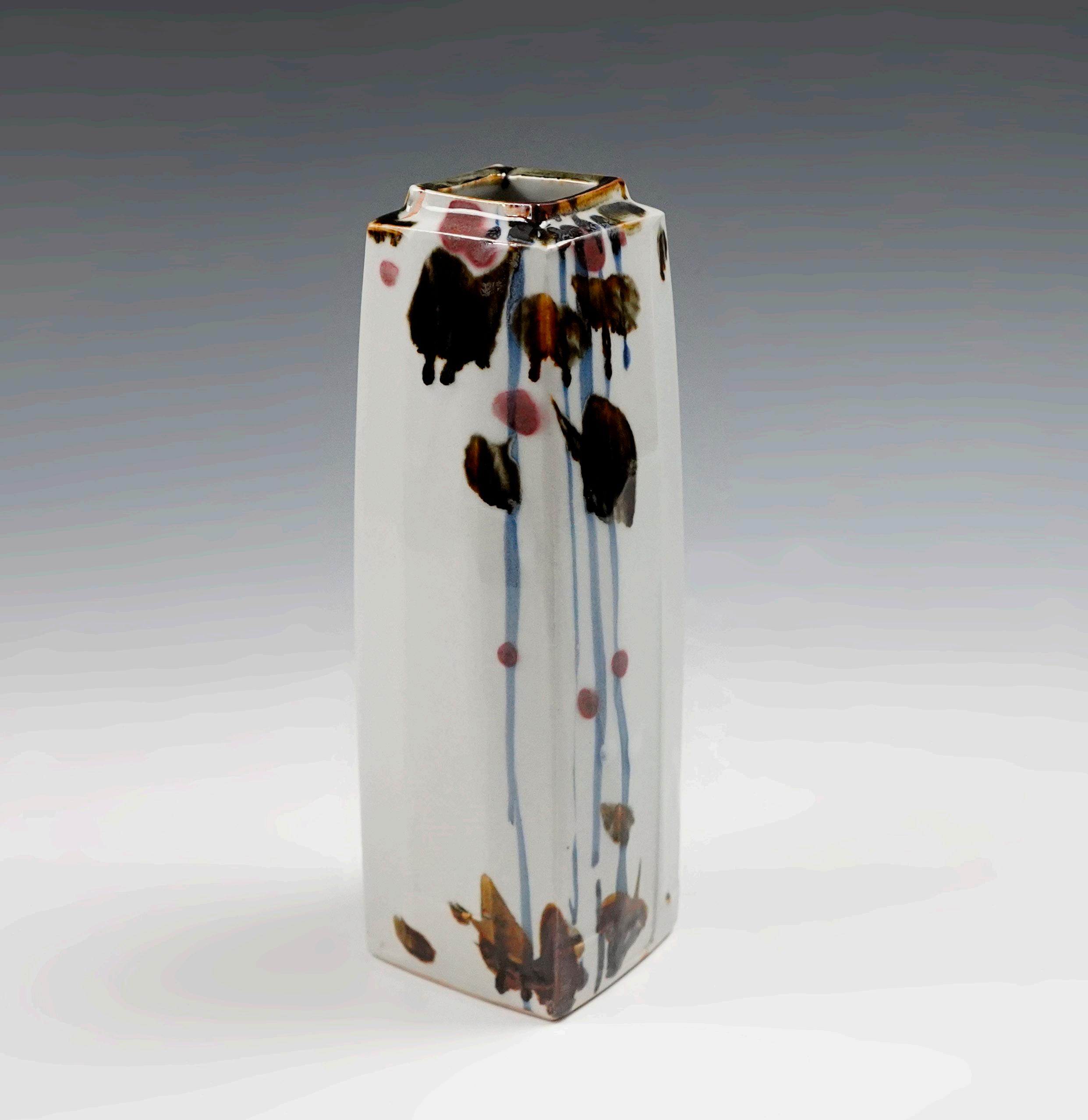
(h) 9.6” x (w) 3.2” x (d) 3.2”; (h) 24.3 x (w) 8.1 x (d) 8.1 cm
Porcelain
With Signed Wood Box

Small Jar in Sansai Glaze 三彩三足小壺 (h) 4.5” x (Diameter) 3”; (h)11.4 x (Diameter) 7.6 cm Stoneware
Signed Wood Box
With
FUJIWARA YU 藤原
The grasses of summer: The remnant dreams of ancient warriors.
Haiku, Matsuo Basho
road to the Deep North”
The famous Fujiwara family boasts two Living National Treasures in pottery. The first designation was Fujiwara Kei (1899-1983), Yu’s father, in 1970. Fujiwara Yu followed in his father’s footsteps by being designated in 1996 for his contributions to the development of Bizen ware. As is obvious from the pieces in the exhibition he was master of firing effects: the botamochi window on the tokkuri-shaped flower vase and the goma effects of the ash on the necks and bodies of the other two pieces. These effects characterized Bizen ware from the 16th century onwards and are part of a small repertoire of firing effects that the iron-containing, unglazed Bizen clay was capable of. To achieve these effects, given the long firing that Bizen ware requires, is indic-
ative of both the skill and experience of the potter.
Fujiwara Yu’s work showcases finely textured surfaces characteristic of Bizen clay. His textures are a result of skillful employment of “goma ‘’, or natural ash glaze. Meanwhile, the clay also boasts the Fujiwara family’s signature purple hue. The gradations from a dark coffee brown to purple under the light creates a distinctive opalescent quality in Fujiwara’s Bizen firing. The gentle subtleties in the Fujiwara clay exemplifies the canon of traditional Bizen decorative techniques.
夏草や 兵(つわもの)どもが
松尾芭蕉
雄 (19322001)
夢の跡
(俳句)
“Narrow

Bizen Tokkuri Shaped Bottle With Grass Incision, 備前擂座線文扁徳利 (h) 13.7” x (w) 10” x (d) 8.5”; (h) 34.7 x (w) 25.4 x (d) 21.5 cm Bizen Stoneware With Signed Wood Box
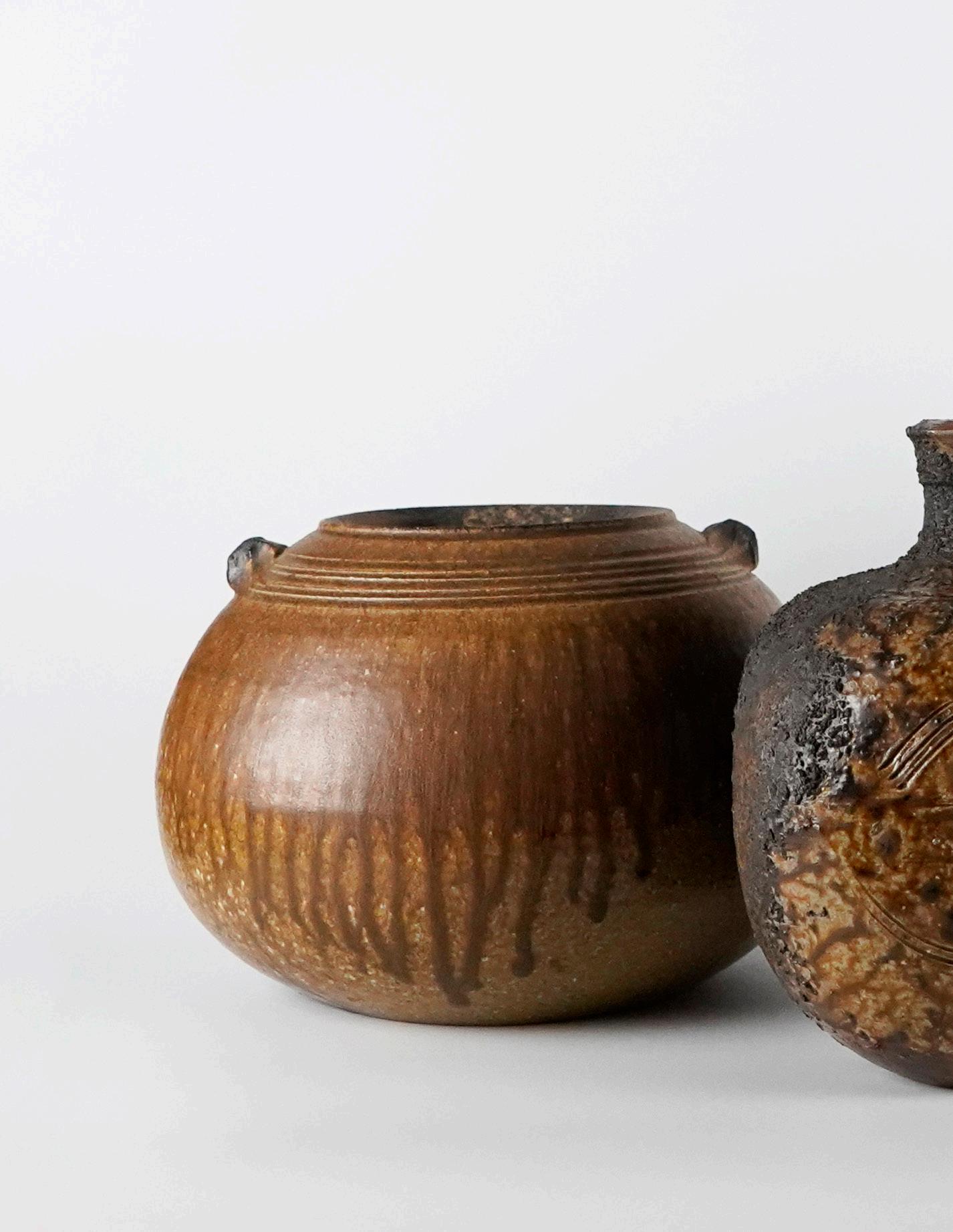

Large Bizen Jar with Ears 備前擂座線文壺
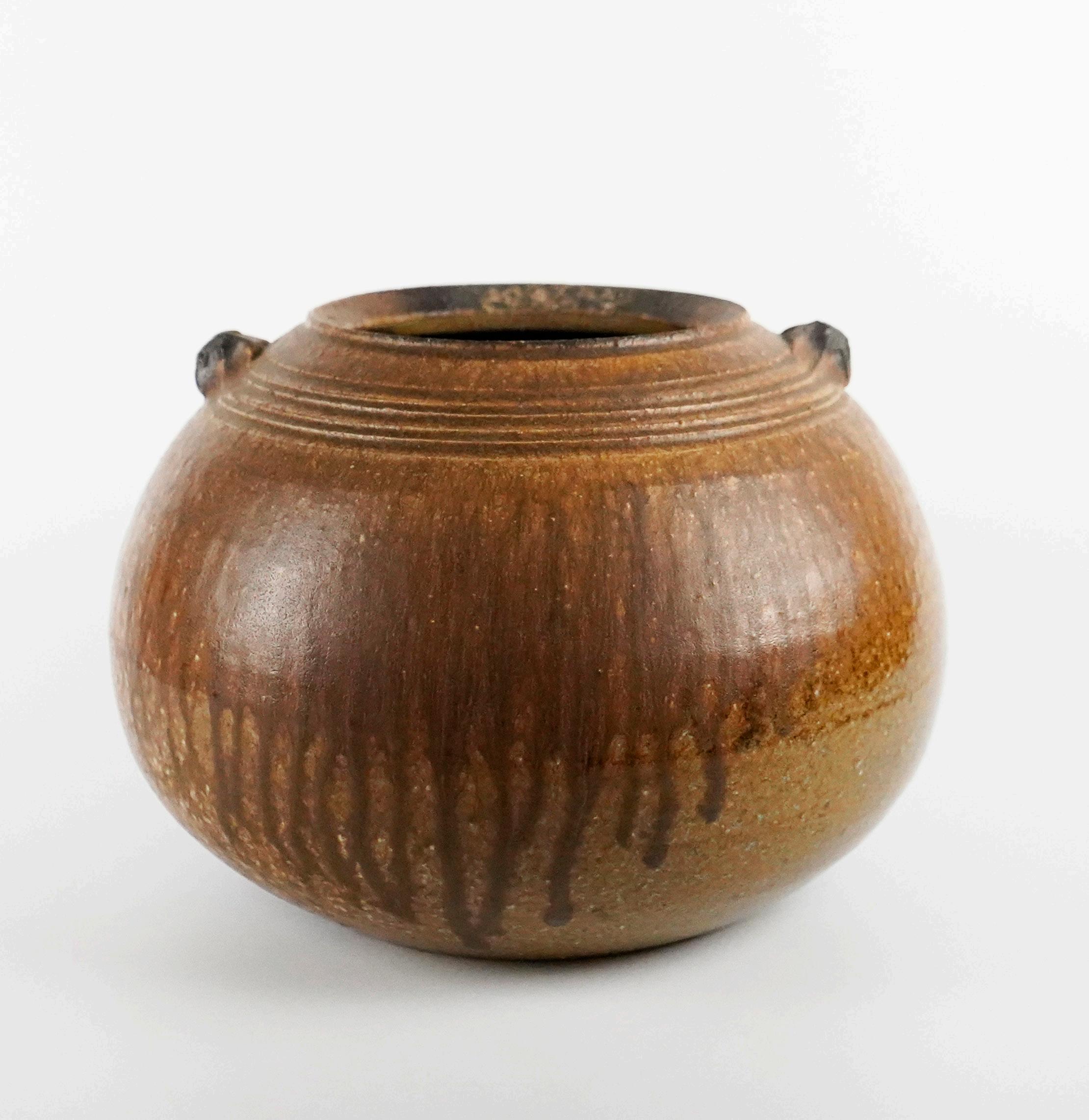
(h) 8.5” x (Diameter) 11.5”; (h) 21.5 x (Diameter) 29.2 cm
Bizen Stoneware
With Signed Wood Box

Yohen Bizen Flower Vase in Tokkuri Shape 備前徳利形窯変花器 (h) 10.2” x (w) 8” x (d) 7”; (h) 25.9 x (w) 20.3 x (d) 17.7 cm Bizen Stoneware With Signed Wood Box
Based in Mashiko, Shimaoka Tatsuzo was also designated in 1996. His designation was for folk craft, particularly his rope-impressed inlay wares (mingei jomon zogan). Shimaoka was a highly skilled potter who mastered and combined a number of techniques. His father made braided silk cords for a living. This familial lineage, combined with his later exposure to rope-impressed Jomon period (c.6000 –300 BCE) earthen wares, enabled him to develop his signature style. His rope impressed surfaces were unique: he added the Korean mishima ware style inlay that he was introduced to by his teacher Hamada Shoji, as Korean ceramics were influential in the mingei movement during the 1920s to 30s.
Of sweetfish
Seeing off salty fish: Farewell.
Finally, his encounter with German salt glazed wares led him to develop a body of work using that technique as well. In this exhibition, the jar with slip glaze (hakeme) reflects Shimaoka’s interest in Korean modes of decoration, whereas the large platter has a cord-impressed, inlaid background with Hamada-style glaze loops to enliven it. They are both exceptional pieces from a great potter with a comprehensive folk craft legacy.
鮎の子の 白魚送る 別れ哉 松尾芭蕉 (俳句)
SHIMAOKA TATSUZO 島岡 達三 (1919-2007)
Haiku, Matsuo Basho
Jar with Ash Glaze in Hakeme Style 野草文花器,1960’s
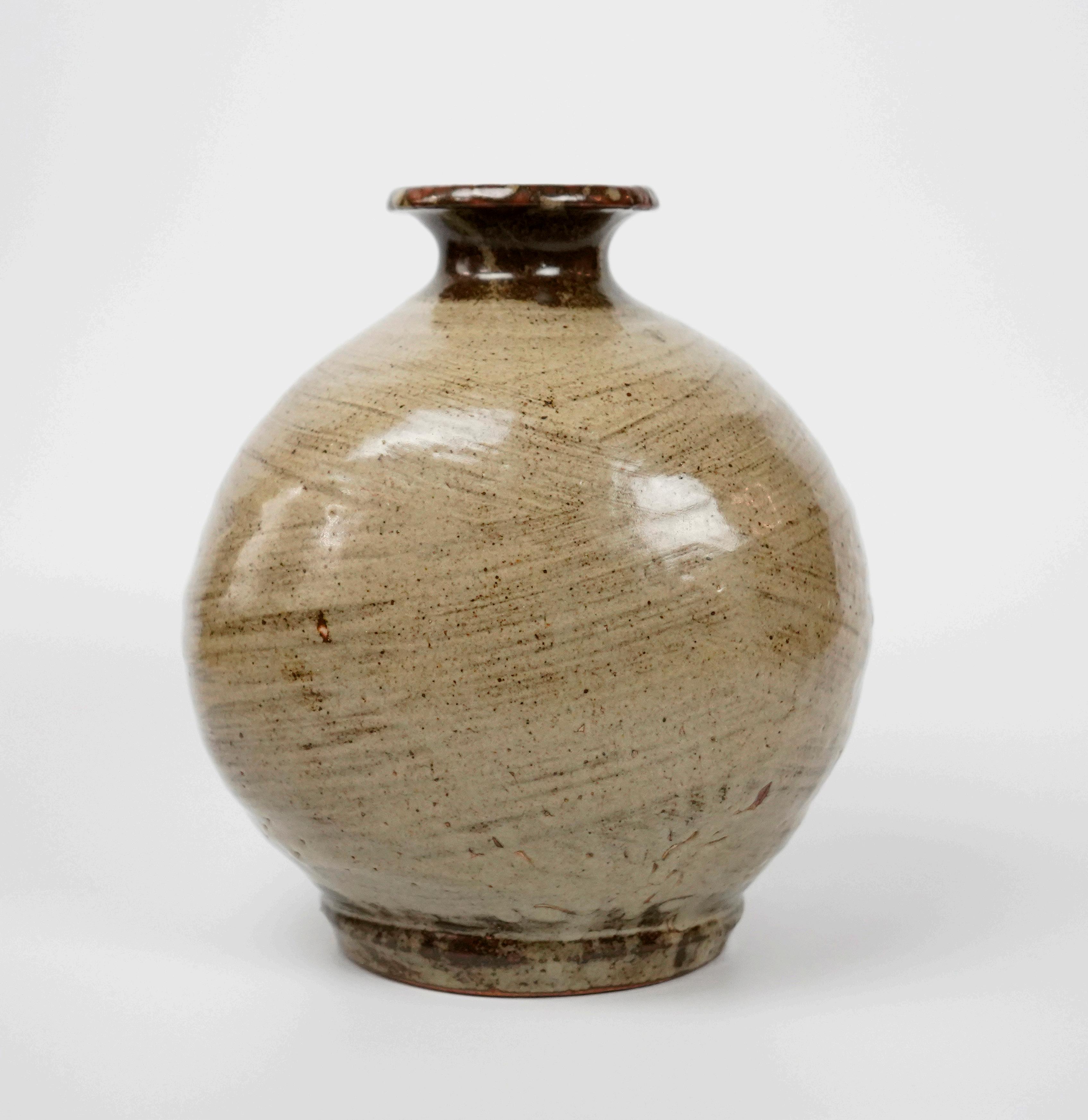
(h) 8.8” x (Diameter) 7.5”; (h) 22.3 x (Diameter) 19.0 cm
Stoneware
With Signed Wood Box
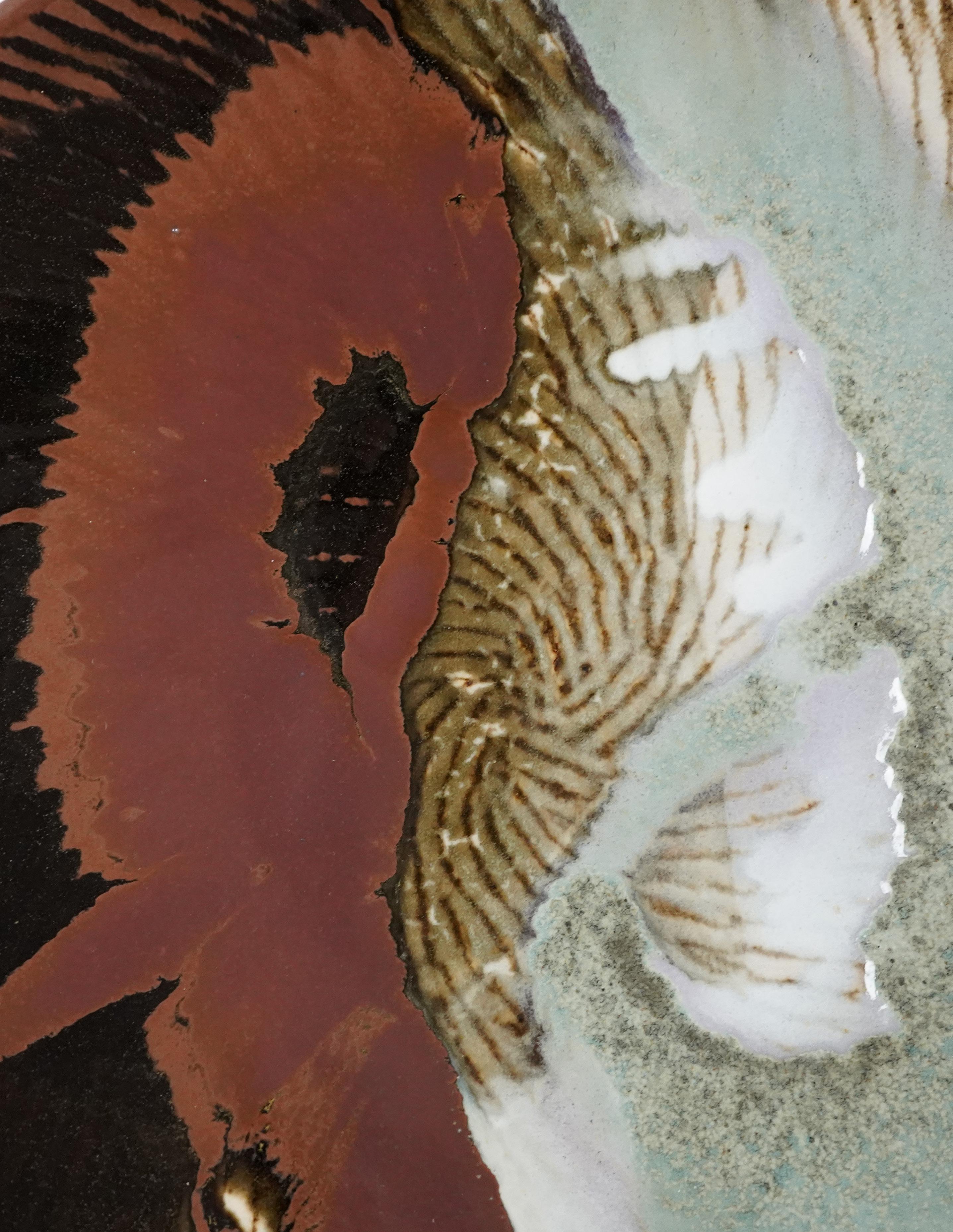
Large Platter with Iron “Fish Trail” on Rope Impressed Surface 掛合釉縄文象嵌流文皿, 1990’s (h) 3.6” x (Diameter) 16.2”; (h) 9.1 x (Diameter) 41.1cm
Stoneware With Signed Wood Box

Tokuda Yasokichi III harked from the Kutani area around Kanazawa, and was designated in 1997 for his production of colourful porcelain (saiyu jiki). Peerless among Japanese ceramicists, Tokuda Yasokichi III uses pigmented glazes on simple forms to create the deep colour of his show-stopping pieces. Passed directly from grandfather to grandson, these glazes were developed by Tokuda Yasokichi I and given with the advice that they would provide for his grandson’s future. Tokuda Yasokichi III has certainly made the best of his family’s techniques through both his own work and that of his studio. His work continues the tradition of colourful decoration that
Cherry Blossoms: on this calm, lambent day of spring, why do you scatter with such unquiet hearts?
Hyakunin Isshu, Kino Tomonori
characterises Kutani ware but in a uniquely contemporary way.
The Kutani canon is famous for its polychrome enamels and glazes. Tokuda’s technique allowed him to control the suffusion of Kutani color glazes to a very high degree, creating precise color compositions that blended one color seamlessly to the next. His saiyu jiki rendered an effect that blurred the lines between design, high art, and craft. Today, his daughter, Tokuda Yasokichi IV continues on the legacy of Kutani ware in Japan with her own unique take on the porcelain type.
TOKUDA YASOKICHI III 3代 徳田八十吉 (1933-2009)
ひさかたの
しづ心なく 花の散るらむ 百人一首 紀友則
光のどけき 春の日に
 (Left) Plate with Polychrome Enamel Overglaze 燿彩大皿,1990’s
(h) 1.8” x (Diameter) 15.4”; (h) 4.8 x (Diameter) 39.2 cm
Porcelain
With Signed Wood Box
(Left) Plate with Polychrome Enamel Overglaze 燿彩大皿,1990’s
(h) 1.8” x (Diameter) 15.4”; (h) 4.8 x (Diameter) 39.2 cm
Porcelain
With Signed Wood Box

(h) 1.8” x (Diameter) 15.4”; (h) 4.8 x (Diameter) 39.2 cm
Porcelain
With Signed Wood Box
Azure Sky Covered Jar 碧空

(h) 4” x (Diameter) 3.2”; (h)10.1 x (Diameter) 8.1 cm
Porcelain
With Signed Wood Box
(Left) Plate with Polychrome Enamel Overglaze 燿彩大皿「輪華」,1990’s
Camellias falling, A rooster crows: and so another falls.
桜井 梅室 (俳句)
The colourful work of Yoshita Minori belies its Kutani origin. As the third generation head of the Kinzan Kiln, Yoshita Minori now bears the torch of carrying on the Yuri-kinsai technique. This glaze type translates to “gold colors beneath” and was developed in the mid 1960s. Yoshita was designated in 2001 for this under-glaze gold decoration. Using gold foil, the decoration is shaped and applied to his vessels. These are then glazed and fired, locking the gold in position. The decoration is rich but its restrained use against subtle background colours creates ceramics of quiet elegance and originality.
tle drop-shadow glow against the polychrome background. Gold leaf is an extremely fragile material, even more so when adhered to the surface of an unglazed vessel. It requires an extraordinarily steady hand followed by very precise heat control during the firing process to get the desired outcome with Yuri-kinsai. Yoshita developed his own technique to enhance the ephemeral and lightweight look of the gold leaf. He applies it using alternating layers of thick and thin gold leaf prior to firing. The thin layers melt slightly into the glaze during firing, creating a transparent effect while the thick layer remains opaque.
Unlike typical brushed-on gold leaf decoration, the Yuri-kinsai technique provides a slight relief on the clay surface, creating a sub -
つばき落ち
鶏鳴き椿 また落ちる
Haiku, Sakurai Baishitsu
YOSHITA
吉田 美統
MINORI
(b. 1932)
Vase with Yurikinasai Decoration (Gold Leaf) 釉裏金彩芙蓉文

(h) 8.4” x (Diameter) 4” x (Lip diameter)1.2”; (h) 21.3 x (Diameter) 10.1 x (Lip Diameter) 3.0 cm
Porcelain
With Signed Wood Box


Vessel with Yurikinasai Decoration (Gold Leaf) 釉裏金彩椿文
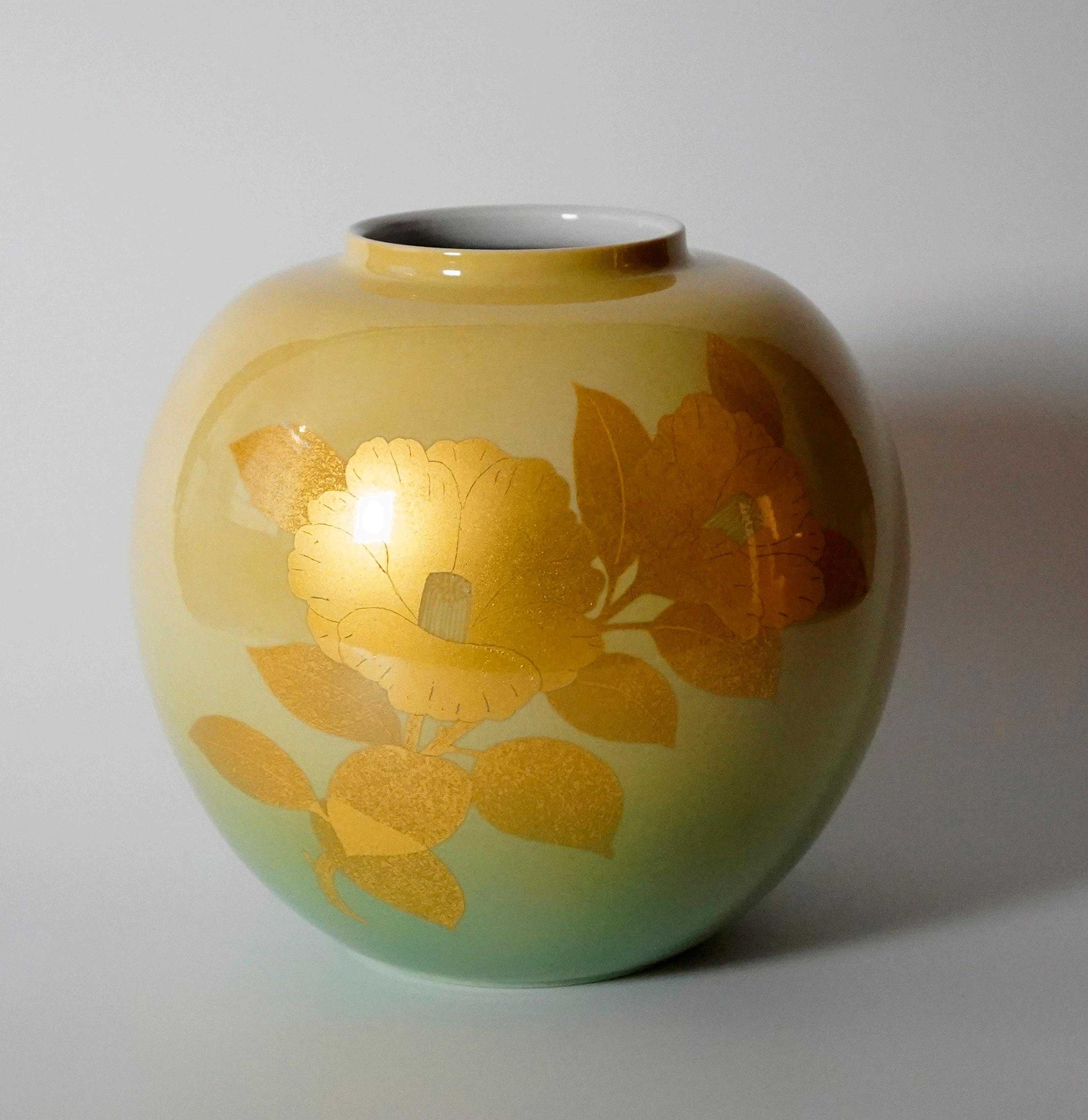
(h) 8.1”x (Diameter) 8.5” x (Lip diameter) 3.8”; (h) 20.5 x (Diameter) 21.5 x (Lip diameter) 9.6 cm
Porcelain
With Signed Wood Box
Vessel with Yurikinasai Decoration (Gold Leaf) 釉裏金彩蔦文 (h) 9.1” x (Diameter) 9.5” x (Lip diameter) 4”; (h) 23.1 x (Diameter) 24.1x (Lip diameter) 10.1 cm
Porcelain With Signed Wood Box
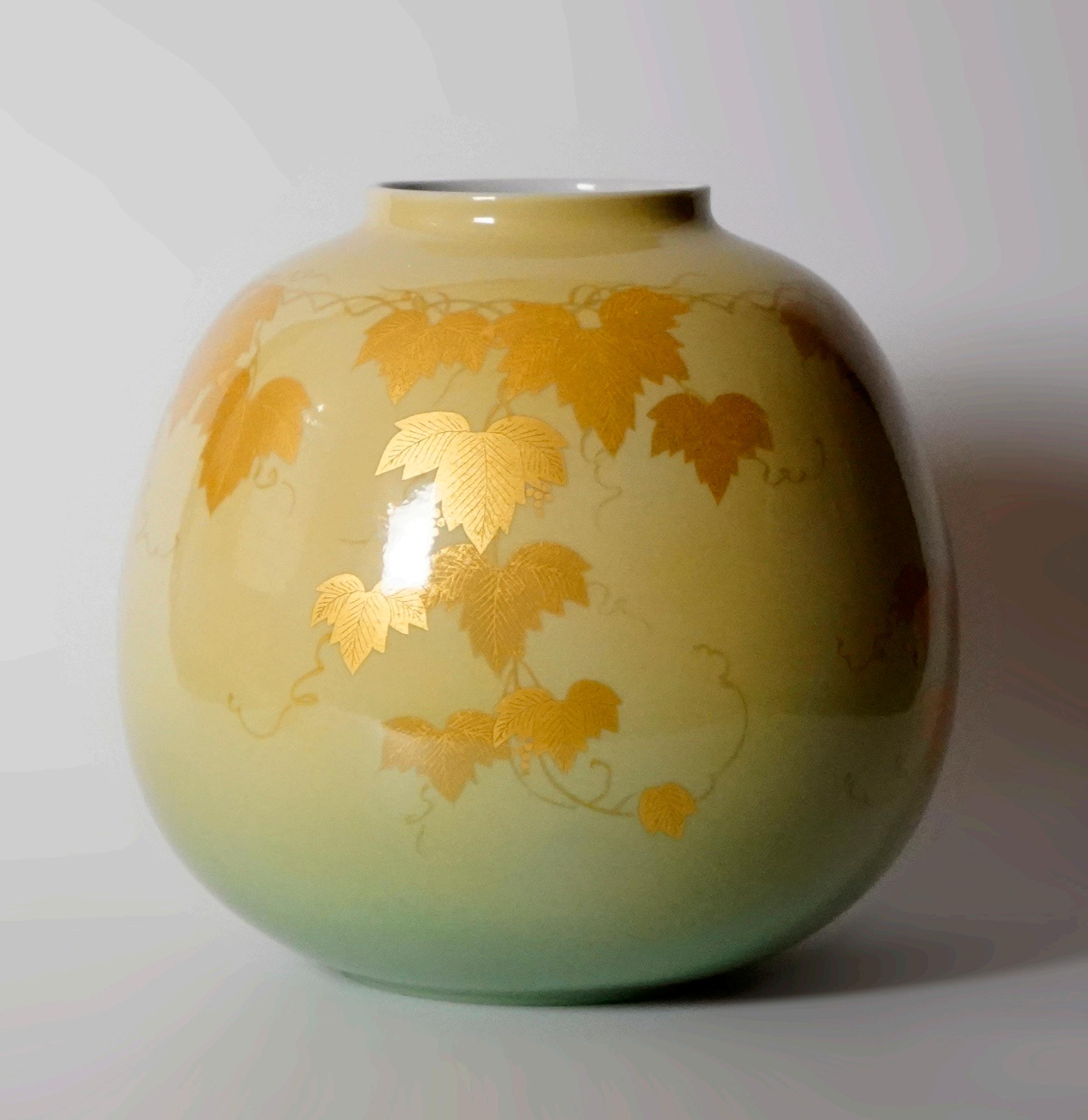
Bizen has had a total of five Living National Treasures over the years and the most recent has been Isezaki Jun, who was designated in 2004. The Bizen jar of his in this show is decorated with another of the repertoire of four techniques used to decorate Bizen ware. This time it is the Hidasuki firing technique that is created when rice-straw cords soaked in seawater are wrapped around the pot, which is then fired. The cords burn away but the salt in the seawater reacts with the iron in the clay to create red stripes. This technique has been used since the 16th century. Again, we see that a modern twist is granted to a centuries old technique by hands of a skilled contemporary potter.
My lowly hut is thatched with straw From fields where rice-sheaves often stand, Now autumn’s harvest well-nigh o’er, Collected by my toiling hand: Through tattered roof, the sky I view: My clothes are wet with falling dew.
Isezaki is also known for having revived the Anagama (single chamber firing) in 1961. The anagama is a type of single-chamber tunnel-like kiln that is dug into a hillside. It’s a firing method that suits natural wood-ash firing, from which successful results are a result of both careful design and fortuitous chance. His works reflect this duality in his planned patterning which frequently takes on a modern, geometric quality, as well as the subtle surface qualities of traditional Bizen clay.
伊勢 崎淳
ISEZAKI JUN
(b. 1936) 秋の田の かりほの庵の 苫をあらみ わが衣手は 露にぬれつつ -天智天皇 (百人一首)
Hyakunin Isshu, Emperor Tenchi
Bizen Jar with Hidasuki Firing Effect Trail 備前壺 (h) 12.3” x (Diameter) 8.5”x (Lip diameter) 2.4”; (h) 31.2 x (Diameter) 21.5 x (Lip diameter) 6.0 cm Bizen Stoneware With Signed Wood Box

HARA KIYOSHI 原 清 (b. 1936)
In the spring fields when mist rises in the air, I grieve.
In the evening light I heard a warbler cry.
Hara Kiyoshi was designated in 2005 for his use of iron-based glazes (tetsu-yu) following in the footsteps of both Shimizu Uichi and Ishiguro Munemaro to become the third LNT designated for using iron-based glazes (after training with both his predecessors). The piece in the exhibition has more in common with Song Dynasty Jun ware, even down to the reduction, copper-red slash, and that’s because Hara’s work draws upon Chinese precursors just as the work of Ishiguro Munemaro and Shimizu Uichi did. This Jun-glazed ware is his second-style, as it were, and he is a master with this just as he is with the traditional browns and blacks we associate with iron containing glazes.
From the 1980s, he began to carve out his
signature style by honing the use of a semiopaque blue glaze. This blue takes on several hues: from a warm Turkish blue, to the greenblue tones of celadon. Other works take on a lighter, cool cobalt.
His immersion into this color over both porcelain and stoneware has earned him the honor of being a Bearer of Intangible Cultural Heritage. He opened his own kiln in Setagaya, Tokyo in 1965. Today, Hara is an active potter and a member of the Japan Kogei Association after having exhibited extensively with an illustrious career consisting of solo exhibitions at Takashimaya, Mitsukoshi Nihonbashi, and other prestigious institutions that have done so much to promote Japanese ceramics.
春の野に 霞たなびき うら悲し この夕かげに うぐひす鳴くも 大伴家持 (万葉集)
Otomo no Yakamochi (Collection of ten thousand leaves)
Jar with Two Ears 鈞窯双耳壺
(h) 11” x (Diameter) 8.6”; (h) 27.9 x (Diameter) 21.8 cm
Stoneware with Jun glaze
With Signed Wood Box

Finally, we get to celadon glazes! Nakajima Hiroshi was designated for his use of celadon in 2007. His forms are inspired by Chinese metal vessels for which he selects the specific celadon tone to match the form. The two works in this exhibition have different forms and different glazes. Managing celadon with this level of specificity is truly challenging as it’s not an easy glaze to use. Nonetheless, Nakajima manages it and preserves this skill in Japan: truly the baseline for a Living National Treasure.
Nakajima’s glazes are historically grounded in Chinese Song dynasty celadon. His pieces are inspired by traditional Chinese metal receptacles, exemplified by an emphasis on the size and scale of vessels. In particular, he studied the forms of Han and Tang dynasty bronze objects from the archives of Japan’s national
By the moon, my forest of water: swathed in robes of blue.
collections, which showcases an extensive history of Chinese archaeology. His interest in archaeology and history is reflected in his works. His deeply considered approach to form, glaze, and surface results in a grandeur that few contemporary celadon potters are able to achieve.
His commitment to tradition reveals a level of detail sought after by many contemporary celadon artists. In particular, his fired glazes took advantage of the thick viscosity that the iconic blue-green glaze offers. As a result, his forms are adorned with a textural sensitivity. Under different light, Nakajima’s vessels offer an undulating surface scape, wherein the craqueleur of his celadon seems to change the color of the glaze. The sea-green landscape of his regal forms shifts into an ocean blue.
中島 宏 (1941-2018)
NAKAJIMA HIROSHI
青衣(ぎぬ)の 月とありわが 水の林 金子兜太 (俳句)
Haiku, Kaneko Touta

Azure Blue Flower Vase 天青花入
(h) 11.7” x (Diameter) 5.5” x (Lip diameter) 3.5”
(h) 29.7 x (Diameter) 13.9 x (Lip diameter) 8.8 cm
Stoneware with Celadon Glaze
With Signed Wood Box
Celadon Jar 青磁 壺

(h) 13.3” x (Diameter) 10”
(h) 33.7 x (Diameter) 25.4 cm
Stoneware with Celadon Glaze
With Signed Wood Box

Designated as a Living National Treasure in 1994, the Mino potter Suzuki Osamu was born in Gifu prefecture in 1934.
He is best known for the revitalization of the Shino glaze technique with modernist surface decoration. He utilizes a slow firing process for his pieces that showcase his mastery over Shino glazes. The milky patterns over several a red underglaze, draws attention to the illusory qualities of Shino techniques: the surfaces of his works have a milky smooth quality to them that evokes surfaces of stones that
have been abraded over time by their surroundings. At the same time, the geometric patterns recall the precipices of mountainous ravines, often sharp, raw, and rough. His mastery over the Shino glaze softens this imagery to evoke the image of a stone smoothed by time and environment, blended with an abstract, modernist sensibility.
SUZUKI OSAMU 鈴木 蔵 (b. 1934)

Shino Flower Vessel 志野花器 (w) 10.7” x (h) 11.2” x (d) 11.3”; (w) 27.2cm x (h) 28.5cm (d) 28.8cm
Stoneware
With Signed Wood Box
GLOSSARY OF ARTIST SEALS & MARKS
Our glossary chapter features images of the pieces alongside the original signed wooden boxes that enclose the artworks in this exhibition. These precious wooden companions are called “Kiribako”. Not only do they protect the objects inside the box while acting as presentation objects alongside the objects, the signed boxes also serve as the provenance of the pieces inside. The boxes are made with Polonia wood, which grows easily in Japan. Unfortunately, oftentimes, the wood can be warped in dry areas and crack. Therefore, storing them in cool places with suitable humidity levels is highly suggested.
The box lid is where one can read provenance.
Usually signed, stamped and titled by the artist, the lid is read from right to left. Typically, the title of the piece is on the right and then the artist’s first name and seals rest on the lower left of the box. In some cases, the artist will sign and title the inside the lid. That being said, some artists treat the boxes as works of art themselves and present boxes that are outside of this convention.
Here, we present a glossary with close-up images of the artist’s original seals on the pieces themselves, or on their accompanying wooden boxes. Examine them closely; train your connoisseurial eye.
TOMIMOTO Kenkichi 富本 憲吉 (1886-1963) Designated LNT in 1955
Covered Jar with Over Glaze Painting in Red, Gold and Silver on Fern Pattern 色地金銀彩 羊歯文蓋付飾壷, 1956
(h) 7” x (Diameter) 10”
(h) 17.7 x (Diameter) 25.4 cm
Porcelain
With Signed Wood Box
ARTIST SEALS & MARKS
HAMADA Shoji 濱田 庄司 (1894 - 1978) Designated LNT in 1955
Flat Jar, Black Iron Glaze with Finger Marks 指描黒角扁壺, 1940’s

(h) 9.3” x (w) 6” x (d) 3”
(h) 23.6 x (w) 15.2 x (d) 7.6 cm
Stoneware With Signed Wood Box

HAMADA Shoji 濱田 庄司 (1894 - 1978) Designated LNT in 1955
Black Glazed Jar with Persimmon Glaze Trailing, 黒釉錆流掛方壺


(h) 9” x (Diameter) 7” x (Lip Diameter) 5.2”
(h) 22.8 x (Diameter)17.7 x (Lip Diameter) 13.2cm
Stoneware
With Signed Wood Box
Signed by His Son HAMADA Shinsaku

HAMADA Shoji 濱田 庄司 (1894 - 1978) Designated LNT in 1955

Hexagonal Vase with Persimmon Glaze and Red and Green Enamel 柿釉赤絵花生, 1960s
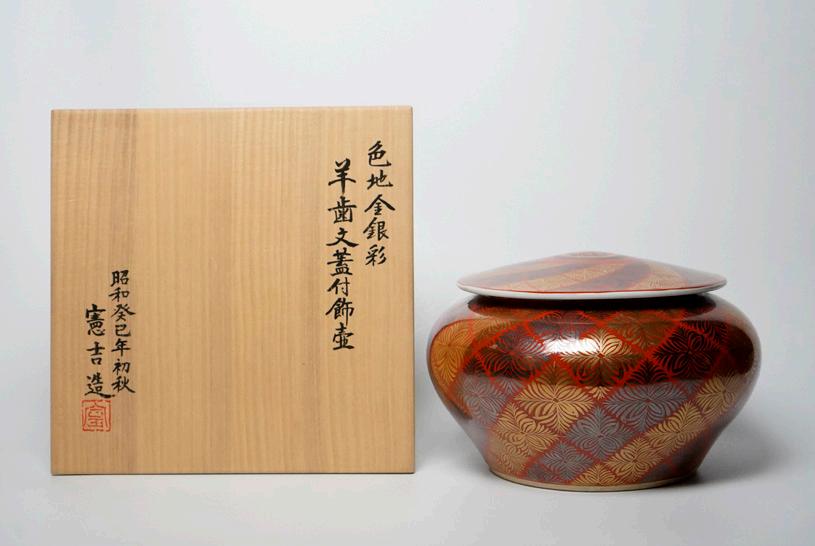
(h) 7.7” x (Diameter) 3.5”; (h) 19.6 x (Diameter) 9 cm
Stoneware
With Signed Wood Box
TOKUDA Yasokichi III 3代 徳田八十吉 (1933-2009)

Designated LNT in 1997
Plate with Polychrome Enamel Overglaze 燿彩大皿


(h) 1.8” x (Diameter) 15.4”
(h) 4.8 x (Diameter) 39.2 cm
Porcelain
With Signed Wood Box

MATSUI Kosei 松井 康成 (1927-2003) Designated LNT in 1993
Jar, Neriage, Glaze Marbleized 練上壺, 1986
(h) 10.2” x (Diameter) 10.2”
(h) 26 x (Diameter) 26 cm
Marbleized Stoneware

With Signed Wood Box
ARTIST SEALS & MARKS
KONDO Yuzo 近藤 悠三 (1902-1985) Designated LNT in 1977
Blue and White Jar with Bamboo, Pine and Plum Drawing 三友 寛
詩染付壺
(h) 9.4” x (Diameter) 9.8”, (h) 23.8 x (Diameter) 24.8 cm
Porcelain
With Signed Wood Box and Lacquer Box
KONDO Yuzo 近藤 悠三 (1902-1985) Designated LNT in 1977
Blue and White Jar with Bamboo, Pine and Plum Drawing 三友 寛
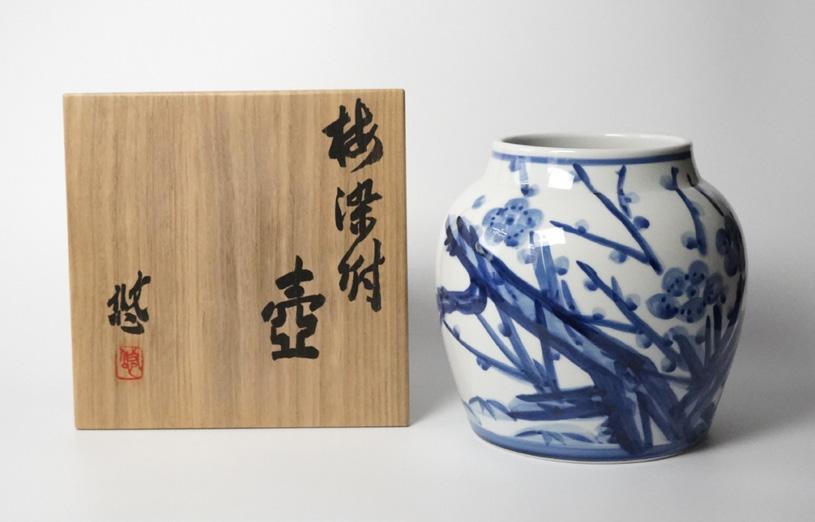

詩染付壺
(h) 9.4” x (Diameter) 9.8”, (h) 23.8 x (Diameter) 24.8 cm
Porcelain
With Signed Wood Box and Lacquer Box
KONDO Yuzo 近藤 悠三 (1902-1985) Designated LNT in 1977
Sometsuke Jar with Thistle Drawing 薊染付壺, 1967

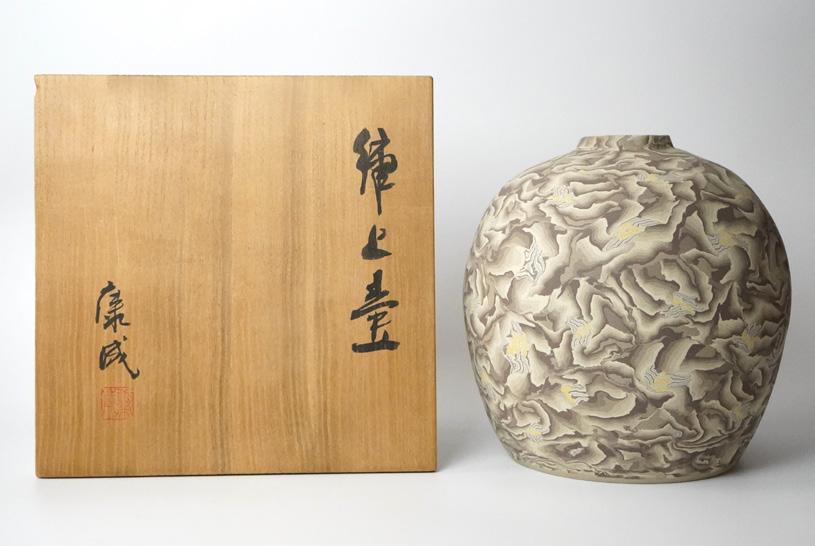

(h) 8.2” x (Diameter) 8.5” x (Lip diameter) 5.4”
(h) 20.8 x (Diameter) 21.5” x (Lip diameter) 13.7cm
Porcelain
With Signed Wood Box
MIWA Kyusetsu XI 11代 三輪 休雪 (1910-2012)
Square Water Jar With White Hagi Ash Glaze 白萩四方水指, 2000s


(h) 6.7” x (w) 7” x (d) 6.6”, Lid: (h) 1.2” x (Diameter) 3.9”
(h) 17 x (w) 17.7 x (d) 16.7cm
Lid: (h) 3cm x (Diameter) 9.9 cm

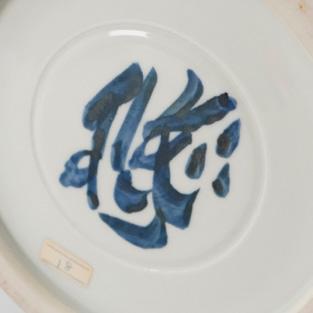
Glazed Stoneware
With Signed Wood Box
SHIMIZU Uichi 清水 卯一 (1926-2004) Designated LNT in 1985
Jar with Finger Scraped Four Seasons Characters on Iron Glaze, 鉄
燿扁壺 春夏秋冬 1988
(h) 10.1” x (w) 8” x (d) 7”
(h) 25.6 x (w) 20.3” x (d) 17.7cm
Stoneware with Iron Glaze
With Signed Wood Box
ARTIST SEALS & MARKS
SHIMIZU Uichi 清水 卯一 (1926-2004) Designated LNT in 1985
Flat Jar with White Glaze Over Iron Glaze 蓬菜掛分扁壺 山河, 1993
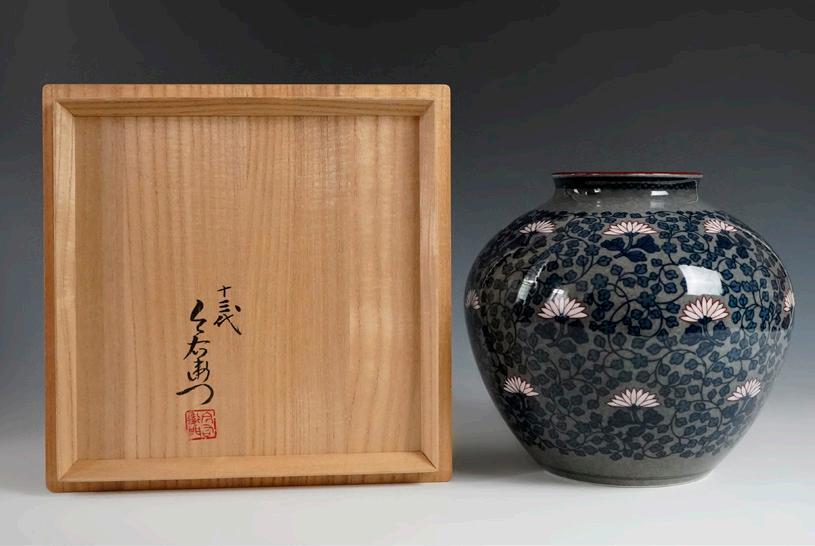
(h) 10” x (w) 8.3” x (w) 7”
(h) 25.4 x (w) 21.0 x (d) 17.7 cm
Stoneware
SHIMIZU Uichi 清水 卯一 (1926-2004) Designated LNT in 1985
Jar with Finger Scraped Patterns on Iron Glaze 鉄燿扁壺, 1988

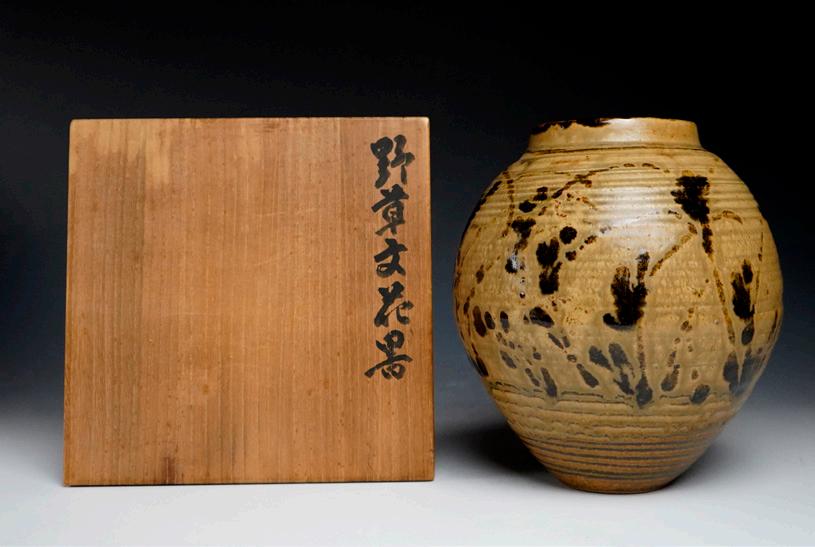
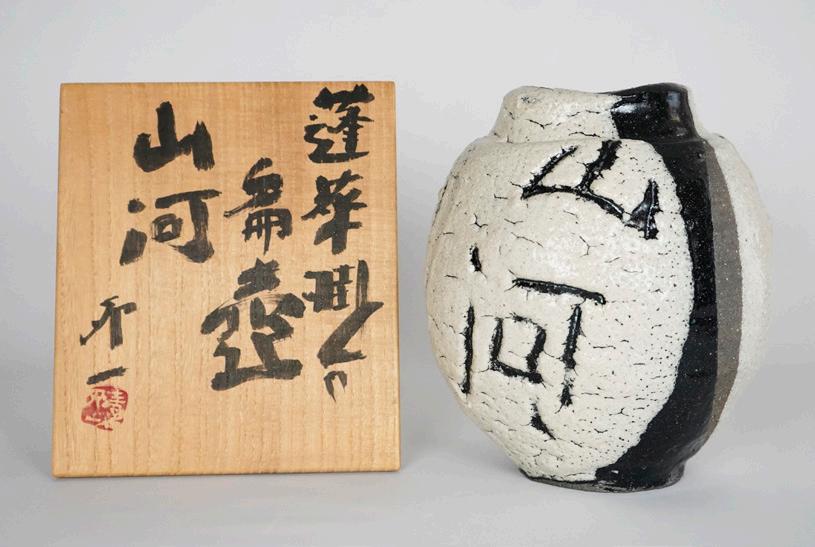
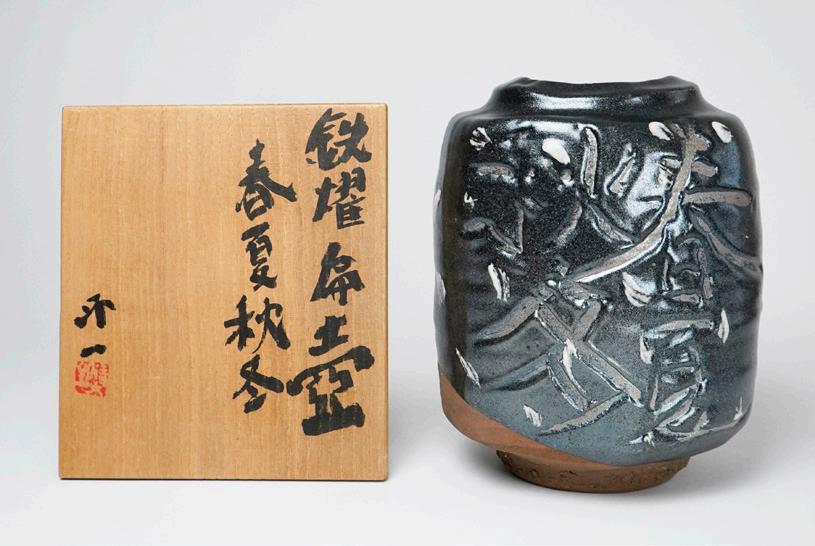
(h) 10.5” x (w) 7.5” x (d) 7”
(h) 26.6 x (w) 19 x (d) 17.7cm
Stoneware with Iron Glaze

With Signed Wood Box
TAMURA Koichi 田村 耕一 (1918-1987) Designated LNT in 1986
Flower Vessel with Iron Drawing of Grass 野草文花器,1960’s
(h) 8.8” x (Diameter) 7.5”
(h) 22.3 x (Diameter) 19.0 cm
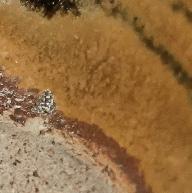
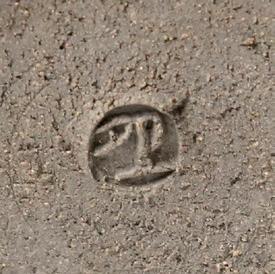
Stoneware

With Signed Wood Box
IMAIZUMI Imaemon XIII 13代 今泉 今右衛門 (1926-2001) Designated in 1989
Vase with Overglaze enamel decoration and flora 色絵 花瓶
(h) 8.4” x (Diameter) 8.5” x (LipDiameter) 4.1”
(h) 21.3 x (Diameter) 21.5 x (Lip Diameter) 10.4 cm
Porcelain
With Signed Wood Box
MATSUI Kosei 松井 康成 (1927-2003) Designated LNT in 1993
Jar, Neriage, Glaze Marbled 萃瓷練上壺 (Suiji Neriage), Early


1990’s
(h) 6.5”x (Diameter) 6.8”
(h) 6.5 x (Diameter) 17.2 cm
Marbleized Stoneware with Clear Glaze
With Signed Wood Box
ARTIST SEALS & MARKS

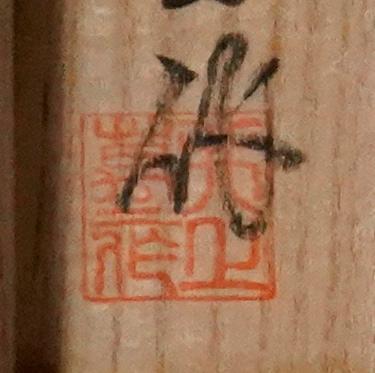
MATSUI Kosei 松井 康成 (1927-2003) Designated LNT in 1993
Jar, Neriage, Cleft Marbled 練上嘯裂壺 (Shoretsu),1985


(h) 7.5” x (Diameter) 8”
(h) 19.0 x (Diameter) 20.3 cm
Marbleized Stoneware
With Signed Wood Box
INOUE Manji 井上 萬二 (b. 1929) Designated LNT in 1995
White Porcelain Jar with Faceted Impression 白磁面取壺
(h) 9.2” x (Diameter) 10” x (Lip diameter) 2.8”
(h) 23.3 x (Diameter) 25.4 x (Lip diameter) 7.1 cm
Porcelain
With Signed Wood Box
INOUE Manji 井上 萬二 (b. 1929) Designated LNT in 1995
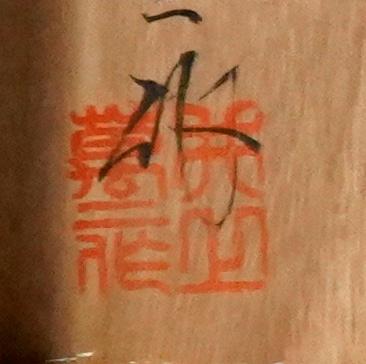
White Porcelain Flower Vessel with Peony Pattern 白磁牡丹彫文花
器
(h) 5.8” x (Diameter) 8.5” x (Lip diameter) 6.5”
(h)14.7 x (Diameter) 21.5 x(Lip diameter) 16.5 cm
Porcelain
With Signed Wood Box
KATO Takuo 加藤 卓夫 (1917-2005) Designated LNT in 1995
Gosu Flower Vase 呉須花挿
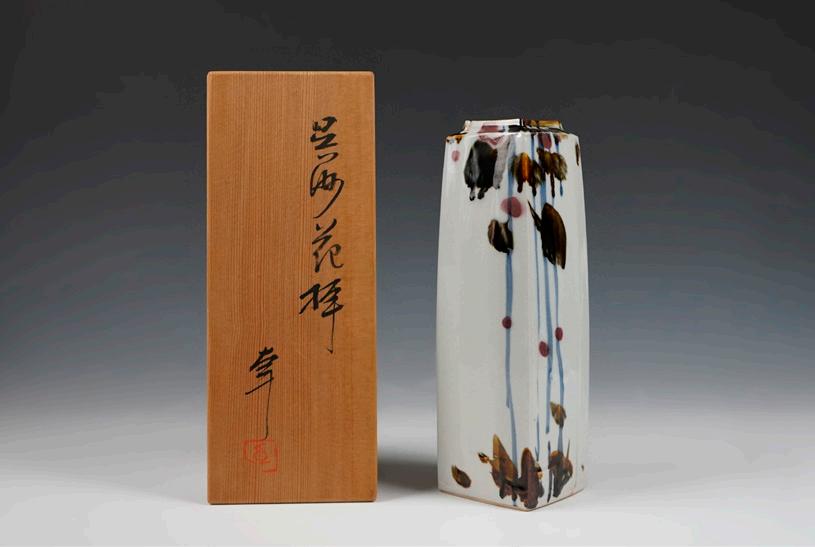
(h) 9.6” x (w) 3.2” x (d) 3.2”
(h) 24.3 x (w) 8.1 x (d) 8.1 cm
Porcelain
With Signed Wood Box


KATO Takuo 加藤 卓夫 (1917-2005) Designated LNT in 1995
Small Jar in Sansai Glaze 三彩三足小壺


(h) 4.5” x (Diameter) 3”
(h)11.4 x (Diameter) 7.6 cm
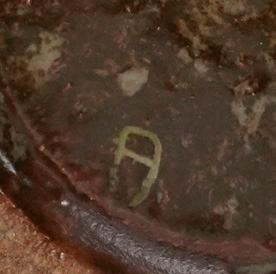

Stoneware
With Signed Wood Box
ARTIST SEALS & MARKS
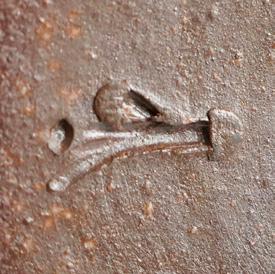

FUJIWARA Yu 藤原 雄 (1932- 2001) Designated LNT in 1996
Bizen Tokkuri Shaped Bottle With Grass Incision 備前擂座線文扁


徳利
(h) 13.7” x (w) 10” x (d) 8.5”
(h) 34.7 x (w) 25.4 x (d) 21.5 cm
Bizen Stoneware
With Signed Wood Box
FUJIWARA Yu 藤原 雄 (1932- 2001) Designated LNT in 1996
Large Bizen Jar with Ears 備前擂座線文壺
(h) 8.5” x (Diameter) 11.5”
(h) 21.5 x (Diameter) 29.2 cm
Bizen Stoneware
With Signed Wood Box
FUJIWARA Yu 藤原 雄 (1932- 2001) Designated LNT in 1996
Yohen Bizen Flower Vase in Tokkuri Shape 備前徳利形窯変花器

(h) 10.2” x (w) 8” x (d) 7”
(h) 25.9 x (w) 20.3 x (d) 17.7 cm
Bizen Stoneware
With Signed Wood Box
SHIMAOKA Tatsuzo 島岡達三 (1919-2007) Designated LNT in 1996
Jar with Hakeme Ash Glaze 地釉刷毛目扁壺

(h) 9.5” x (w) 8.5” x (d) 6.5”
(h) 24.1 x (w) 21.5 x (d) 16.5 cm
Stoneware
With Signed Wood Box
SHIMAOKA Tatsuzo 島岡 達三 (1919-2007) Designated LNT in 1996
Large Platter with Iron Fish Trailed on Rope Impressed Inlay 掛合

釉縄文象嵌流文皿, 1990’s

(h) 3.6” x (Diameter) 16.2”; (h) 9.1 x (Diameter) 41.1cm
Stoneware
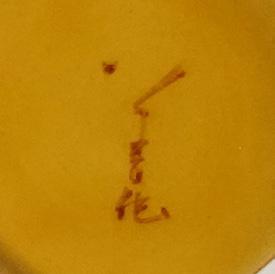
With Signed Wood Box
ARTIST SEALS & MARKS
TOKUDA Yasokichi III 3代 徳田八十吉 (1933-2009) Designated LNT in 1997
Plate with Polychrome Enamel Overglaze 燿彩大皿「輪華」,1990’s
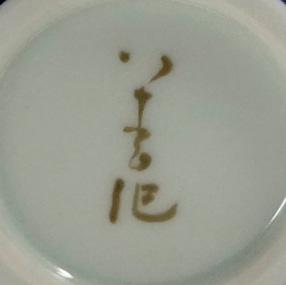
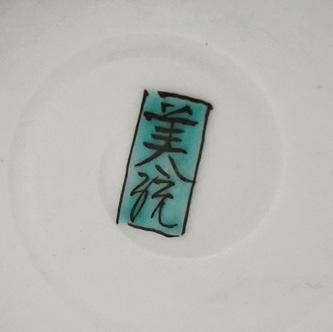

(h) 1.8” x (Diameter) 15.4”
(h) 4.8 x (Diameter) 39.2 cm
Porcelain
With Signed Wood Box
TOKUDA Yasokichi III 3代 徳田八十吉 (1933-2009) Designated LNT in 1997
Azure Sky Covered Jar 碧空
(h) 4” x (Diameter) 3.2”; (h)10.1 x (Diameter) 8.1 cm
Porcelain
With Signed Wood Box
YOSHITA Minori 吉田 美統 (b. 1932) Designated LNT in 2001
Vase with Yurikinasai Decoration (Gold Leaf) 釉裏金彩芙蓉文
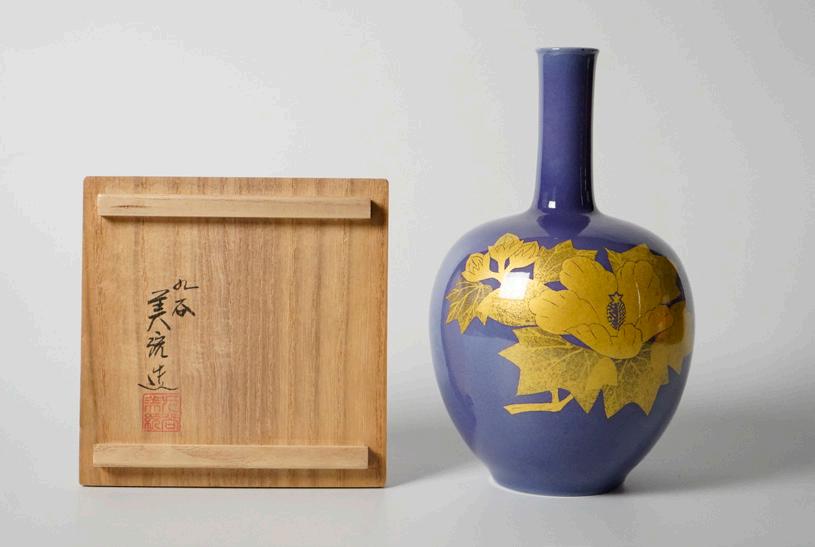
(h) 8.4” x (Diameter) 4” x (Lip diameter)1.2”
(h) 21.3 x (Diameter) 10.1 x (Lip Diameter) 3.0 cm
Porcelain
With Signed Wood Box
YOSHITA Minori 吉田 美統 (b. 1932) Designated LNT in 2001
Vessel with Yurikinasai Decoration (Gold Leaf) 釉裏金彩蔦文


(h) 9.1” x (Diameter) 9.5” x (Lip diameter) 4”
(h) 23.1 x (Diameter) 24.1x (Lip diameter) 10.1 cm
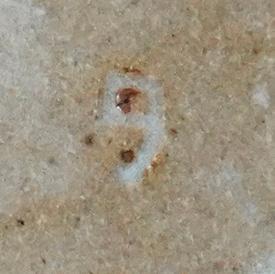
Porcelain
With Signed Wood Box
YOSHITA Minori 吉田 美統 (b. 1932) Designated LNT in 2001
Vessel with Yurikinasai Decoration (Gold Leaf) 釉裏金彩椿文
(h) 8.1”x (Diameter) 8.5” x (Lip diameter) 3.8”
(h) 20.5 x (Diameter) 21.5 x (Lip diameter) 9.6 cm
Porcelain
With Signed Wood Box
ARTIST SEALS & MARKS

ISEZAKI Jun 伊勢崎 淳 (b. 1936) Designated LNT in 2004
Bizen Jar with Burnt Rice Straw Trial 備前壺
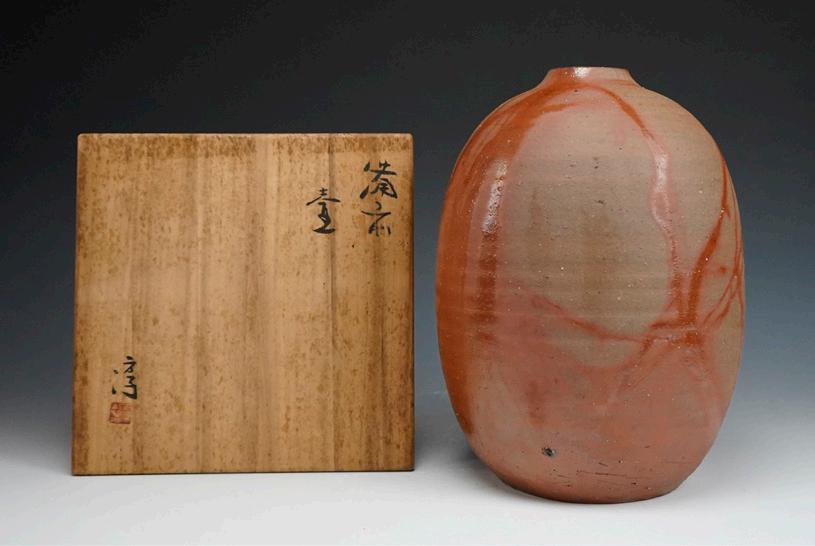
(h) 12.3” x (Diameter) 8.5”x (Lip diameter) 2.4”
(h) 31.2 x (Diameter) 21.5 x (Lip diameter) 6.0 cm
Bizen Stoneware

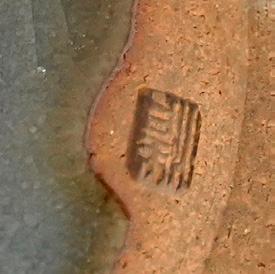
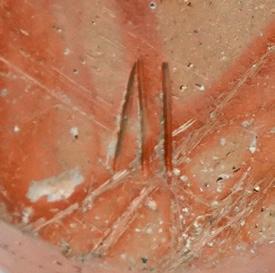
With Signed Wood Box
HARA Kiyoshi 原 清 (b. 1936) Designated LNT in 2005
Jar with Two Ears 鈞窯双耳壺

(h) 11” x (Diameter) 8.6”
(h) 27.9 x (Diameter) 21.8 cm
Stoneware
With Signed Wood Box
NAKAJIMA Hiroshi 中島 宏 (1941-2018) Designated LNT in 2007
Celadon Jar 青磁 壺
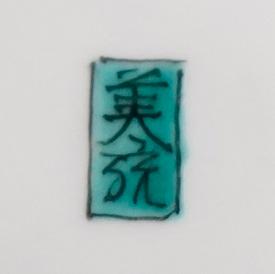

(h) 13.3” x (Diameter) 10”
(h) 33.7 x (Diameter) 25.4 cm
Stoneware with Celadon Glaze
With Signed Wood Box
NAKAJIMA Hiroshi 中島 宏 (1941-2018) Designated LNT in 2007
Azure Blue Flower Jar 天青花入


(h) 11.7” x (Diameter) 5.5” x (Lip diameter) 3.5”
(h) 29.7 x (Diameter) 13.9 x (Lip diameter) 8.8 cm
Stoneware with Celadon Glaze
With Signed Wood Box
SUZUKI Osamu 鈴木 蔵 (b. 1934) Designated LNT in 1995
Shino Flower Vessel 志野花器
(w) 10.7” x (h) 11.2” x (d) 11.3”
(w) 27.2cm x (h) 28.5cm (d) 28.8cm

Stoneware With Signed Wood Box

ARTIST SEALS & MARKS

CATALOG PRODUCTION
Miyazaki Haruka 宮崎 晴香 Kristie Lui 呂 文諺
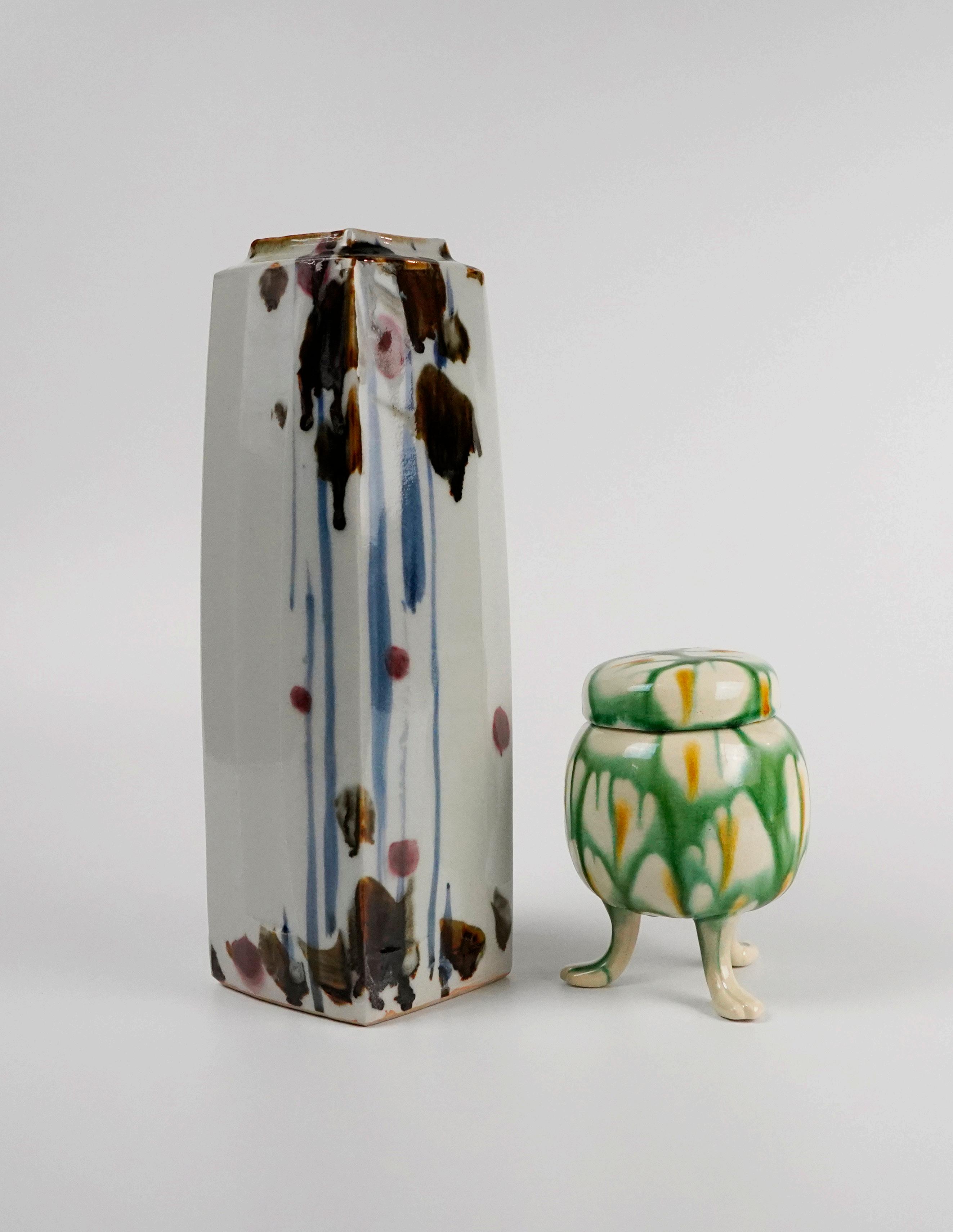
For all sale, acquisition, loan, pricing, consignment or other enquiries, please get in touch via email on our website [daiichiarts.com] or phone [+1 212 230 1680] or [+1 917 435 9473].
販売、買収、ローン、または委託に関するお問い合わせは、メ ール または電話 [+1 212 230 1680] [+1 917 435 9473] にご連絡下さ
いませ。


DAI ICHI ARTS, LTD. 18 East 64th Street, Suite 1F New York, NY, 10065, USA 212.230.1680 | 917.435.9473 www.daiichiarts.com










 Covered Jar with Over Glaze Painting in Red, and Fern Pattern in Gold and Silver 色地金銀彩 羊歯文蓋付飾壷, 1956 (h) 7” x (Diameter) 10”; (h) 17.7 x (Diameter) 25.4cm Porcelain With Signed Wood Box
Covered Jar with Over Glaze Painting in Red, and Fern Pattern in Gold and Silver 色地金銀彩 羊歯文蓋付飾壷, 1956 (h) 7” x (Diameter) 10”; (h) 17.7 x (Diameter) 25.4cm Porcelain With Signed Wood Box
 Flat Jar, Black Iron Glaze with Finger Marks 指描黒角扁壺, 1940’s (h) 9.3” x (w) 6” x (d) 3” ; (h) 23.6 x (w) 15.2 x (d) 7.6 cm
Stoneware
With Signed Wood Box
Flat Jar, Black Iron Glaze with Finger Marks 指描黒角扁壺, 1940’s (h) 9.3” x (w) 6” x (d) 3” ; (h) 23.6 x (w) 15.2 x (d) 7.6 cm
Stoneware
With Signed Wood Box
 Pictured below: a group of works by Hamada Shoji, including three Mukozuke side dishes:
Pictured below: a group of works by Hamada Shoji, including three Mukozuke side dishes:



 Blue and White Jar with Plum Drawing 梅染付壺
(h) 9.5” x (Diameter)9.8 ”
(h) 24.1 x (Diameter) 24.8 cm
Porcelain
With Signed Wood Box and Lacquer Box
Blue and White Jar with Plum Drawing 梅染付壺
(h) 9.5” x (Diameter)9.8 ”
(h) 24.1 x (Diameter) 24.8 cm
Porcelain
With Signed Wood Box and Lacquer Box





 Jar with
on Iron Glaze 鉄燿扁壺, 1988 (h) 10.5” x (w) 7.5” x (d) 7”; (h) 26.6 x (w) 19 x (d) 17.7cm Stoneware with Iron Glaze With Signed Wood Box
Jar with
on Iron Glaze 鉄燿扁壺, 1988 (h) 10.5” x (w) 7.5” x (d) 7”; (h) 26.6 x (w) 19 x (d) 17.7cm Stoneware with Iron Glaze With Signed Wood Box









 Porcelain Flower Vessel Incised with Peony Pattern 白磁牡丹彫文花器
Porcelain Flower Vessel Incised with Peony Pattern 白磁牡丹彫文花器











 (Left) Plate with Polychrome Enamel Overglaze 燿彩大皿,1990’s
(h) 1.8” x (Diameter) 15.4”; (h) 4.8 x (Diameter) 39.2 cm
Porcelain
With Signed Wood Box
(Left) Plate with Polychrome Enamel Overglaze 燿彩大皿,1990’s
(h) 1.8” x (Diameter) 15.4”; (h) 4.8 x (Diameter) 39.2 cm
Porcelain
With Signed Wood Box

























































































